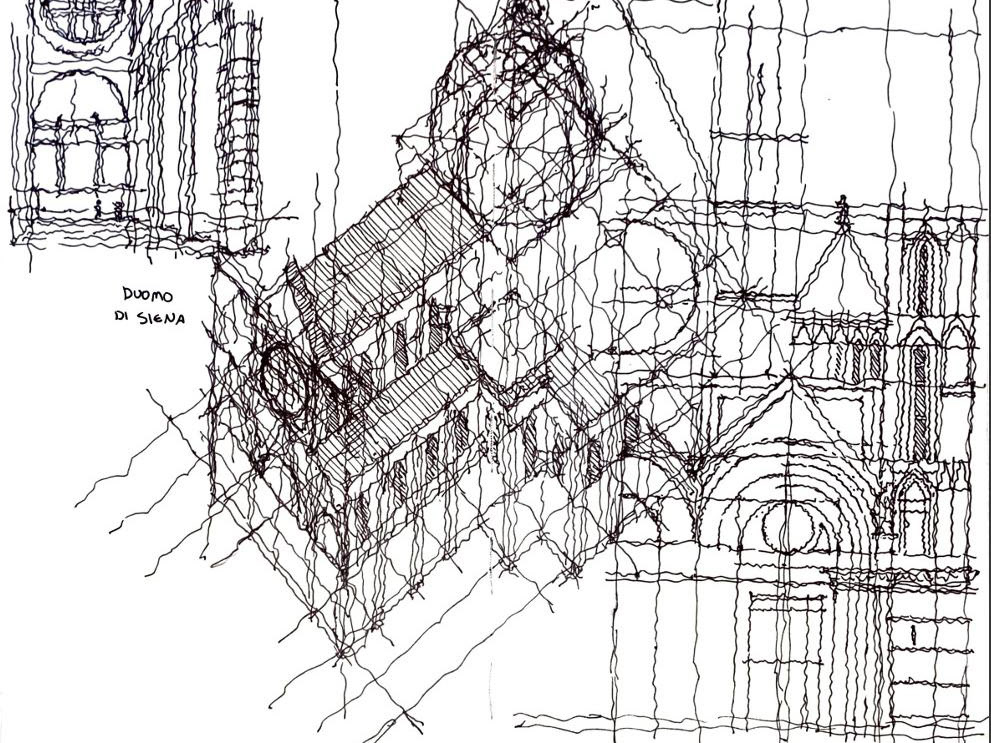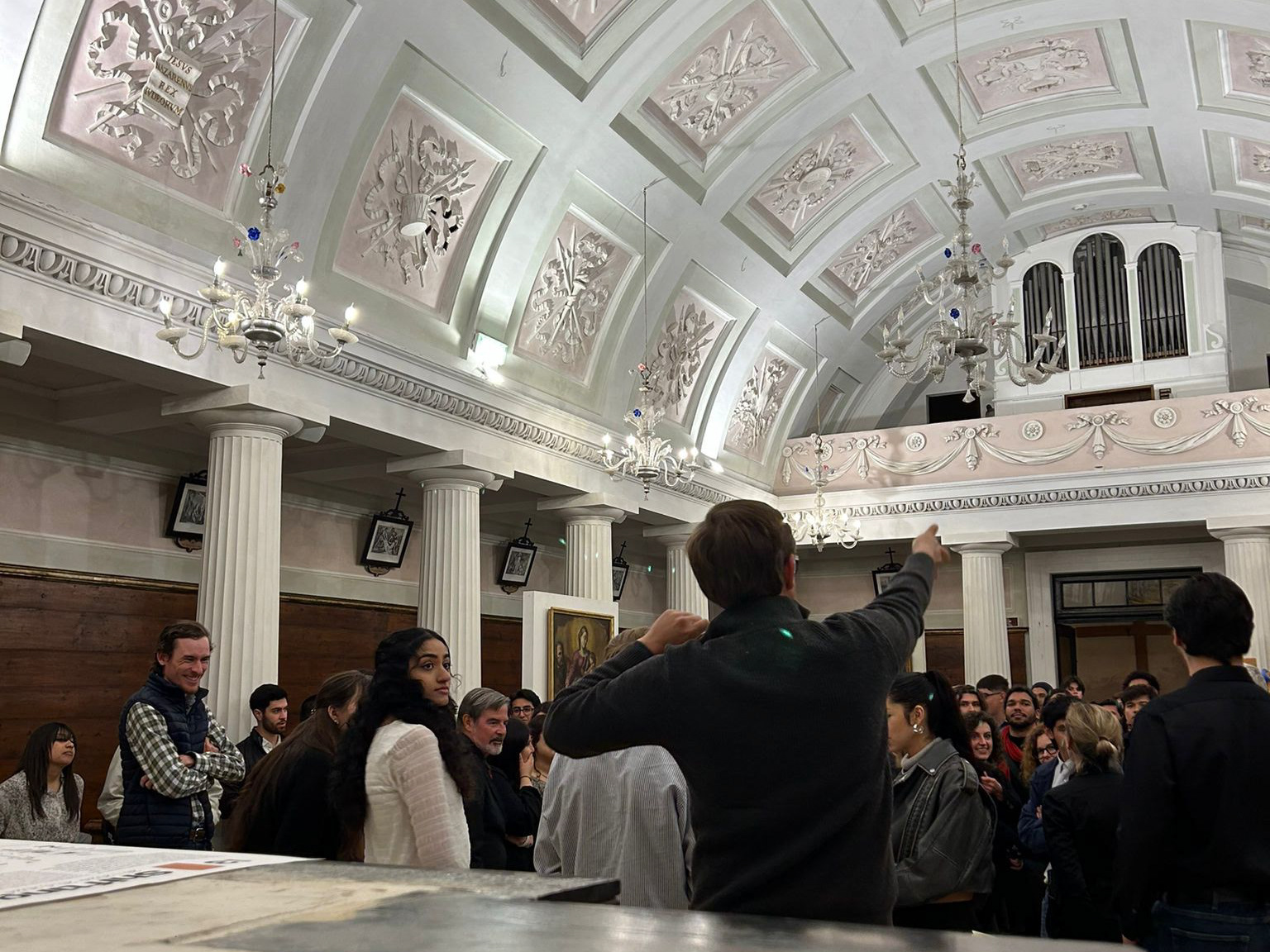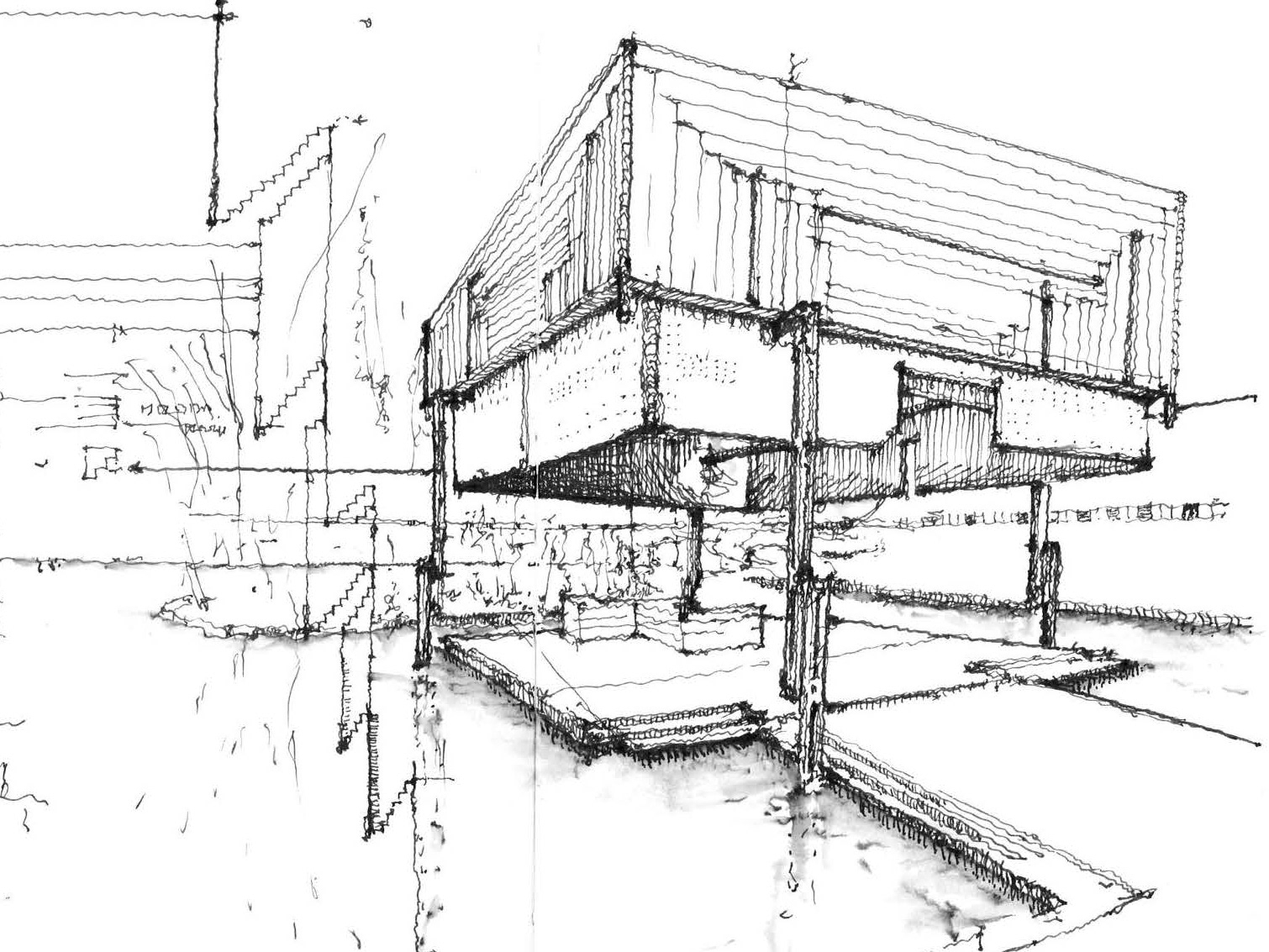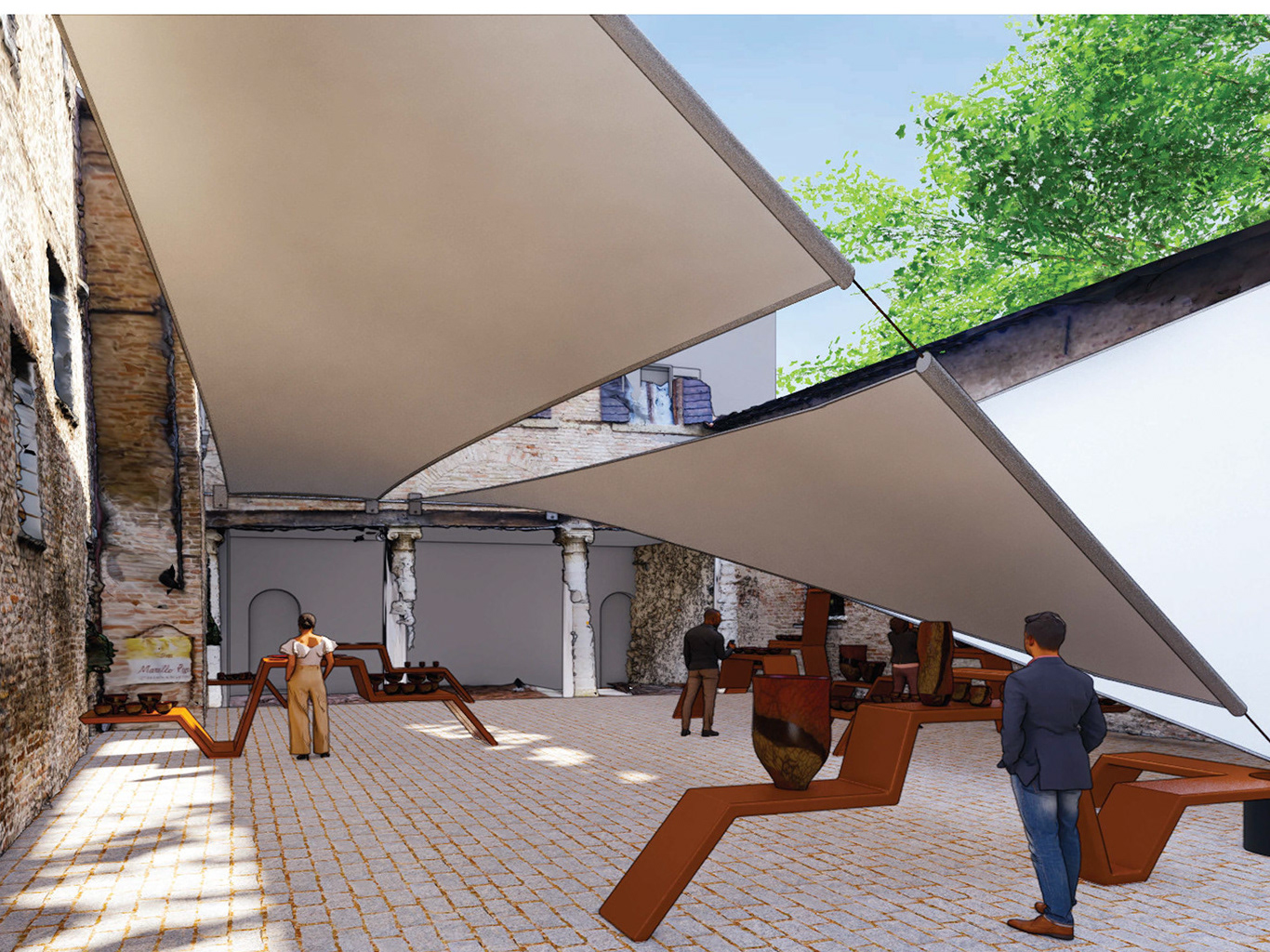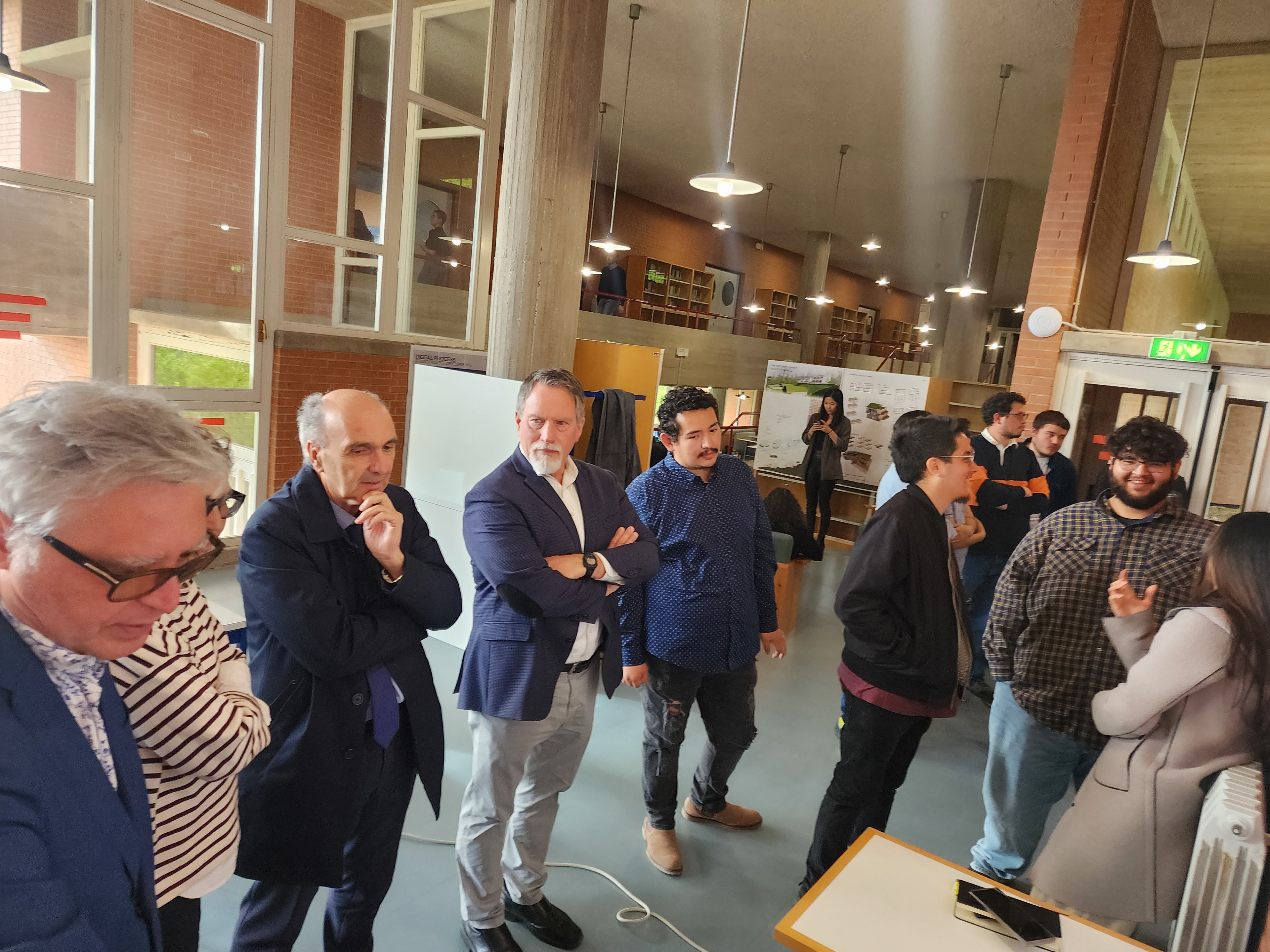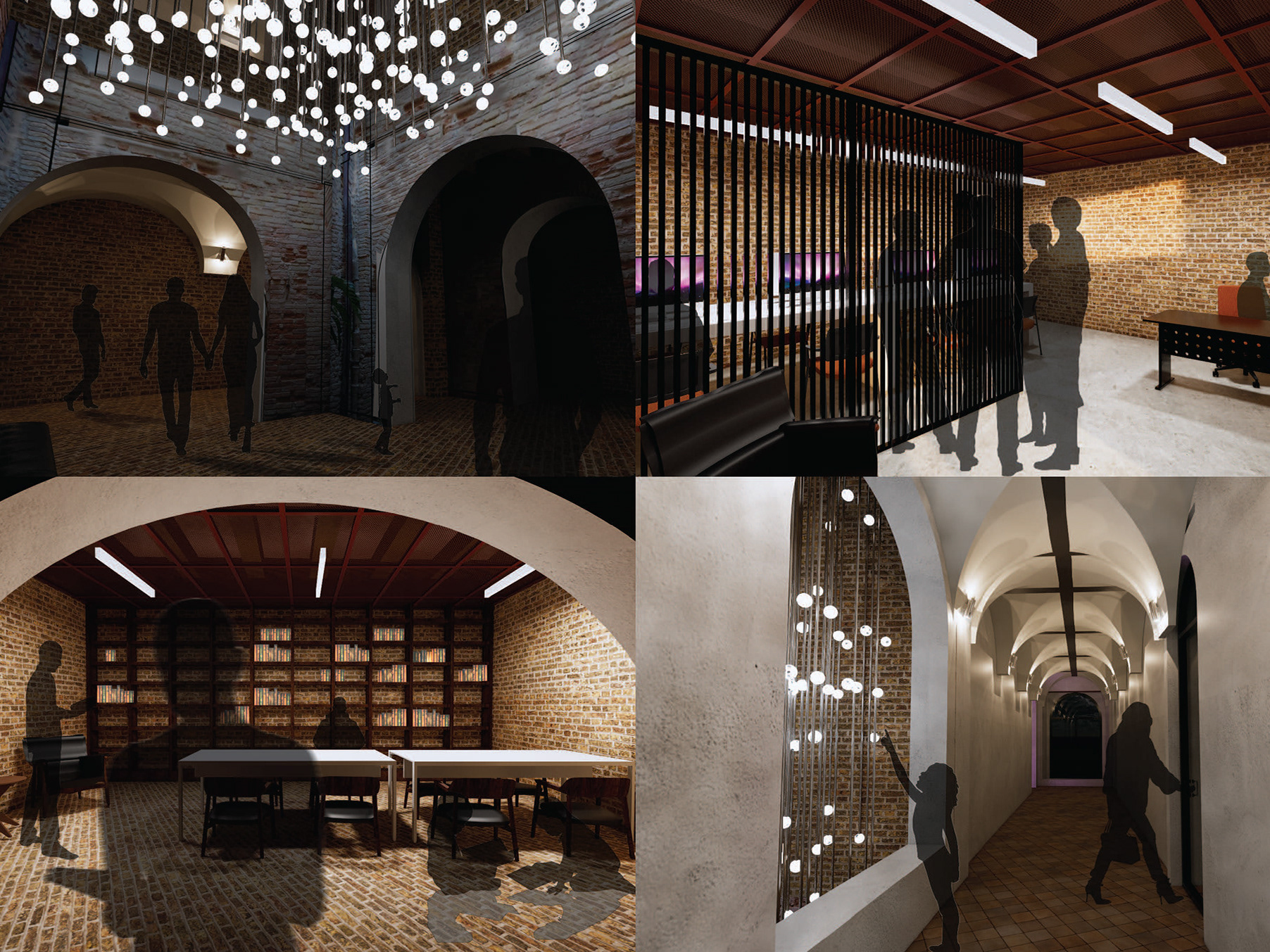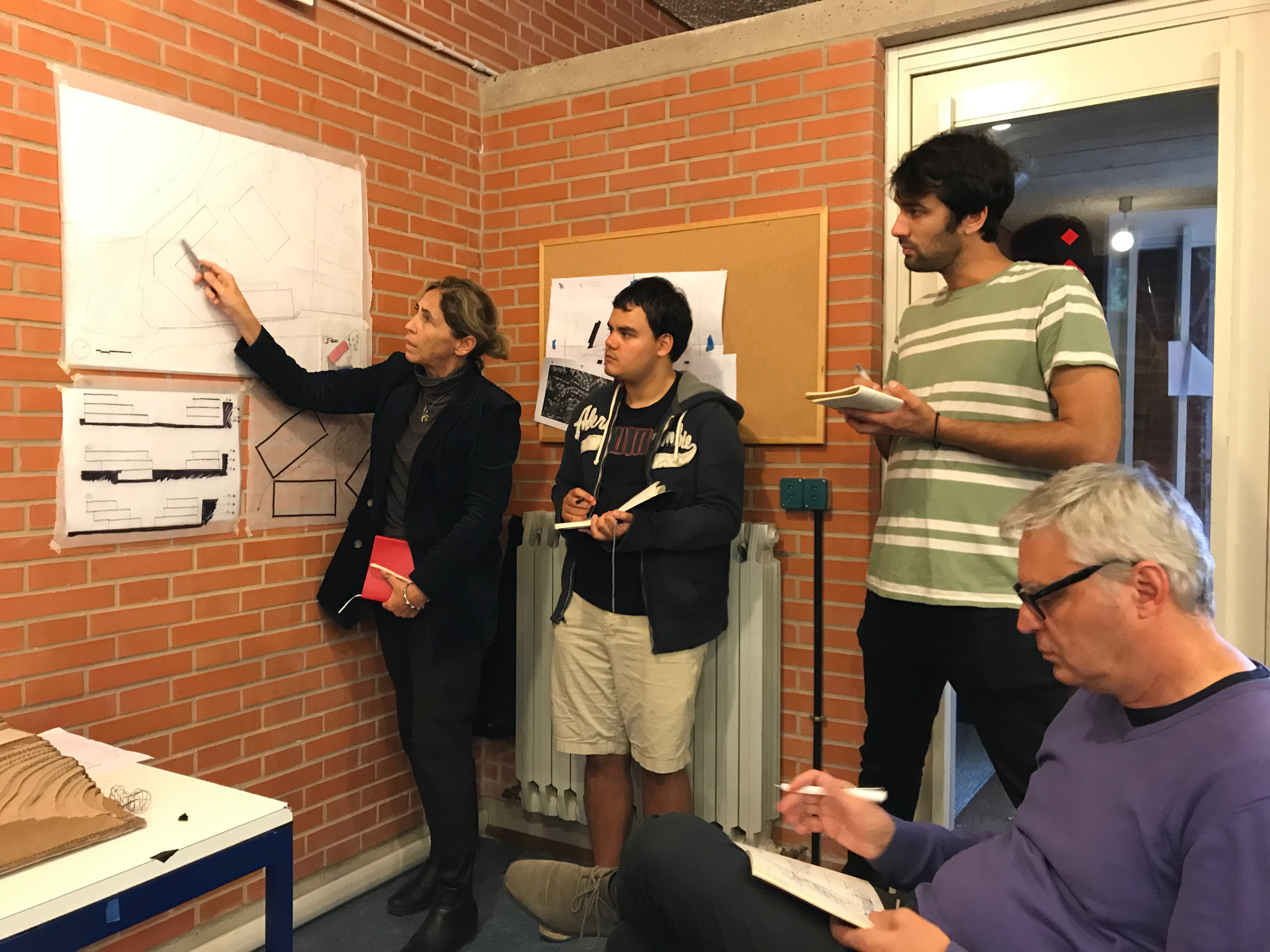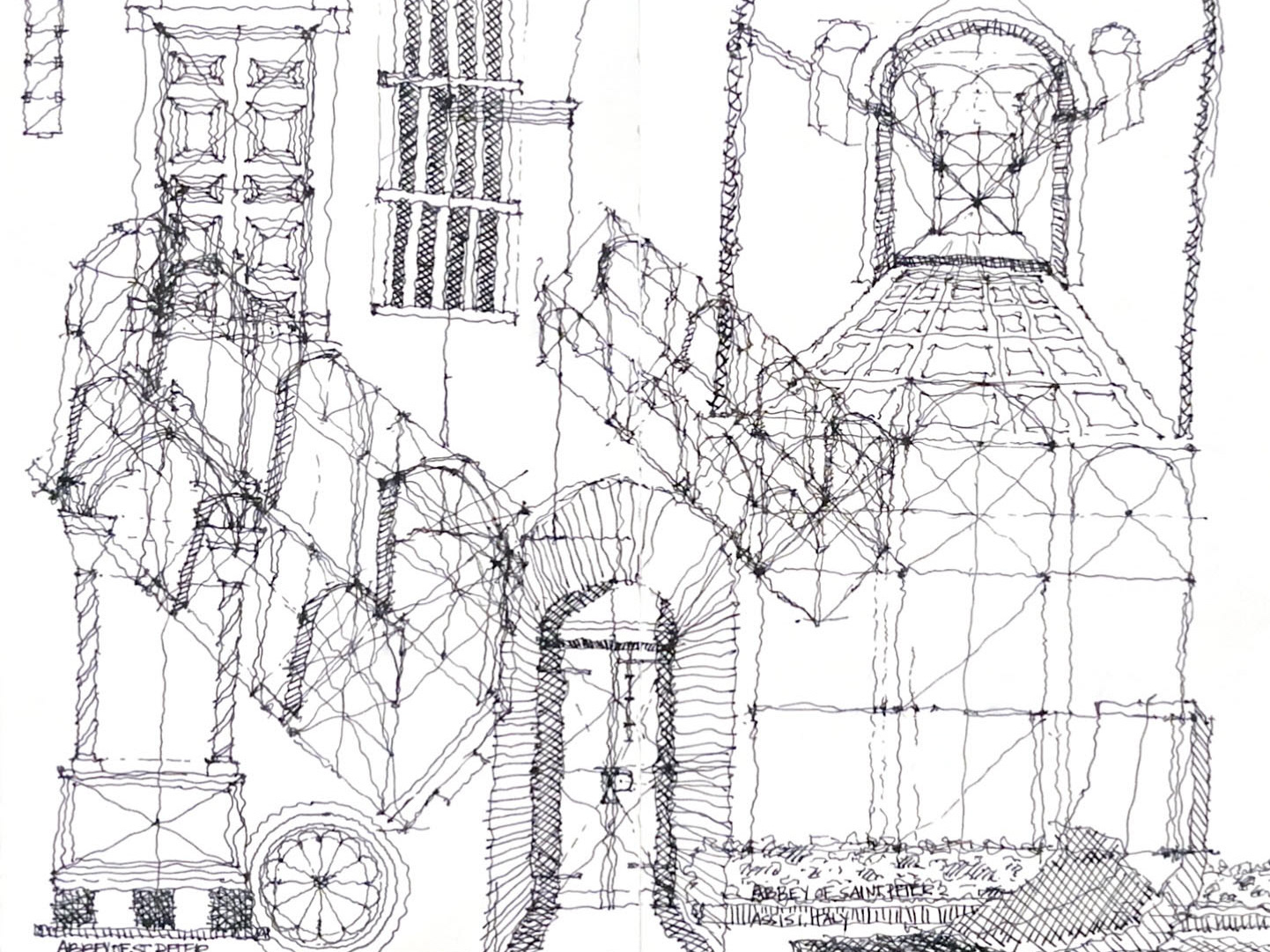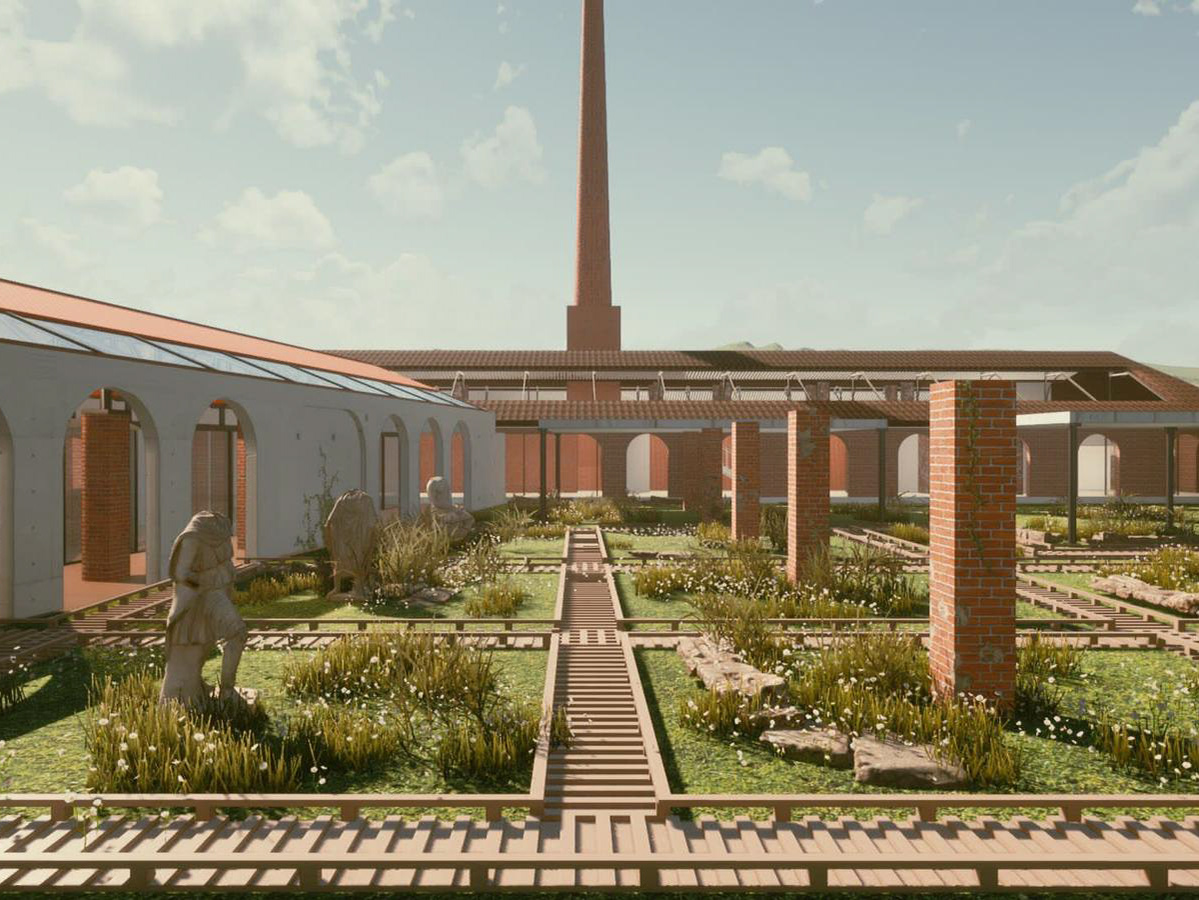IL MUSEO NASCOSTO: Past and Present in the Palazzo Ducale
Building on the collaboration of the past ten years between the UTSA School of Architecture + Planning, the Città di Urbino and the Università degli Studi di Urbino, this project is based on the reimagining of the “Museo Nascosto” in the lower level of the Palazzo Ducale. These spaces constitute a hidden museum, perhaps, but also one that inspires the potential of new uses and new life and a more prominent presence in the community. The student work envisions diverse ways of incorporating contemporary expressions of space and function within the majestic rooms planned in the 15th century by Francesco di Giorgio, creating a dialogue that spans the subsequent generations. On the occasion of the 20th anniversary of Carlo Bo’s death and the numerous remembrances of his profound involvement with the city of Urbino, the conversation over time between Bo and Giancarlo De Carlo regarding the Palazzo sets the stage for the investigation of the physical power of these spaces and how they can speak to us in our own time.
Nato dalla collaborazione che dura da dieci anni tra la UTSA School of Architecture + Planning, la Città di Urbino e l’Università degli Studi di Urbino, questo progetto si basa sulla rivisitazione del “Museo Nascosto” nel livello inferiore del Palazzo Ducale. Questo spazio costituisce, forse, un museo nascosto, ma anche uno che ispira potenziali nuove funzionalità e nuova vita, oltre che una più prominente presenza nella vita della comunità. Il lavoro degli studenti propone diversi modi di incorporare espressioni contemporanee dello spazio e delle sue funzioni all’interno delle magnifiche stanze progettate da Francesco di Giorgio nel XV secolo, creando un dialogo che abbraccia le generazioni seguenti. In occasione del 20° anniversario della morte di Carlo Bo’ e delle numerose celebrazioni del suo profondo coinvolgimento nella città di Urbino, la conversazione nel corso del tempo tra Bo’ e Giancarlo De Carlo riguardo al Palazzo getta le basi per un’investigazione sul potere fisico di questi spazi e su come questi possano interagire con noi nel nostro tempo.
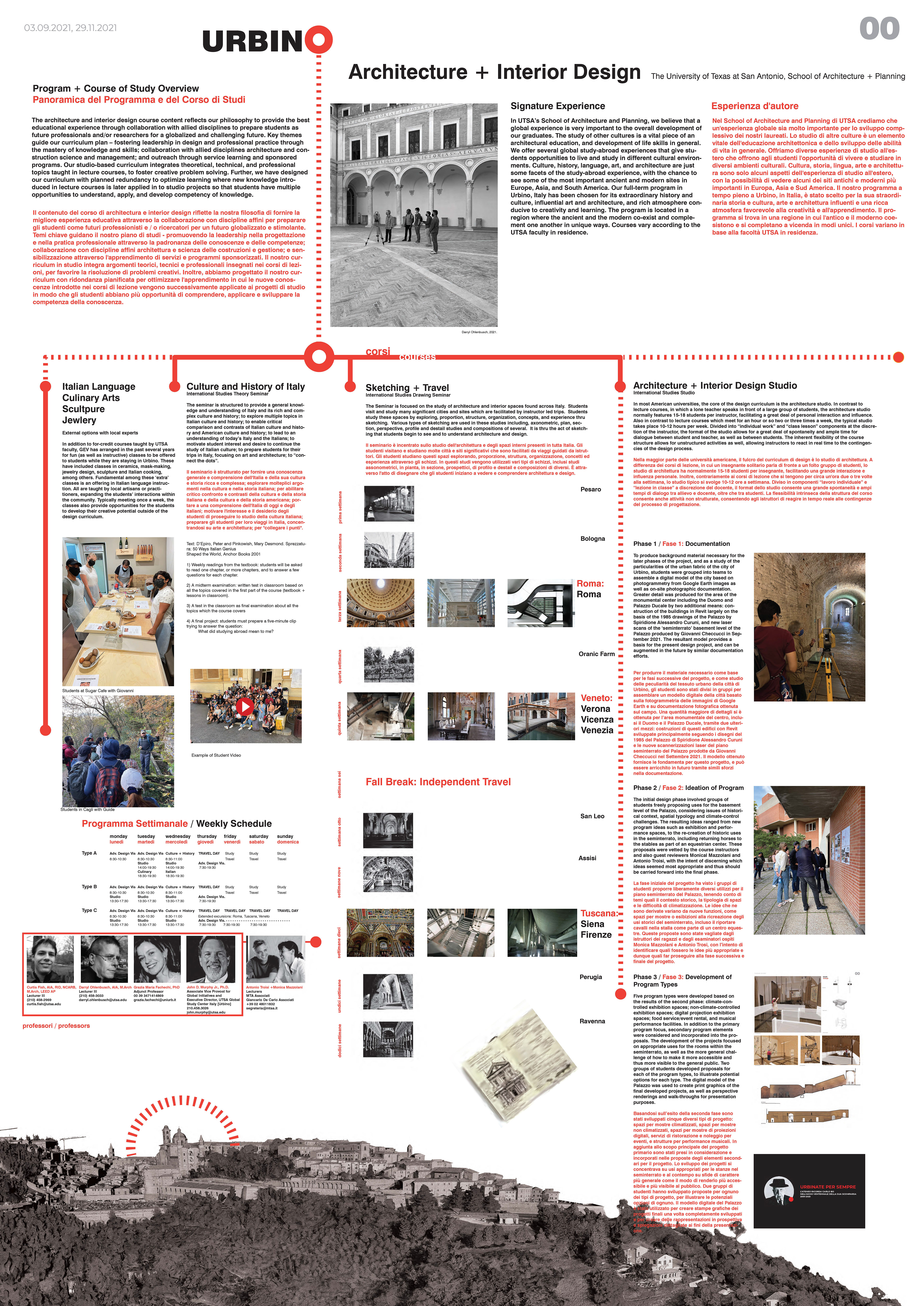
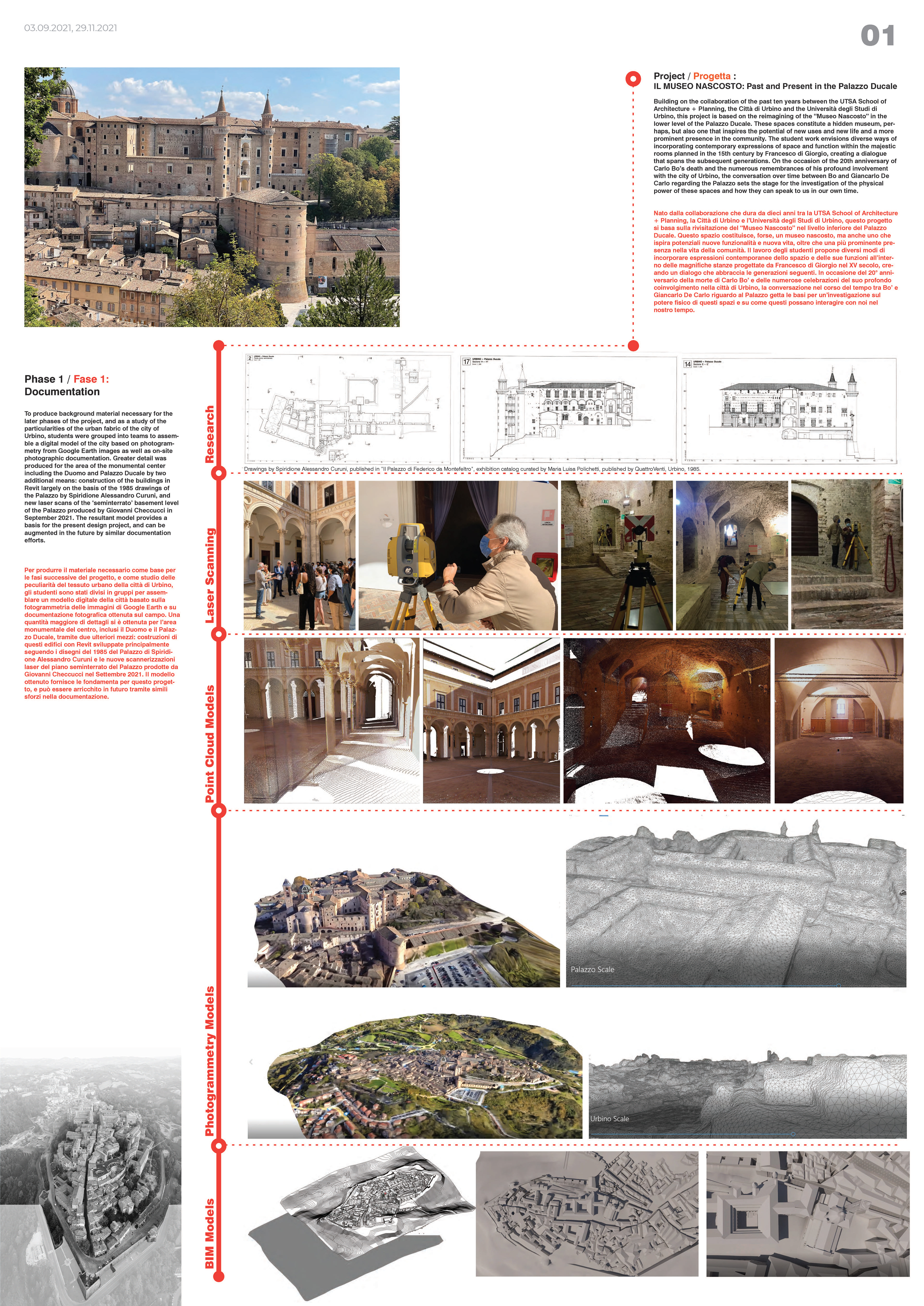
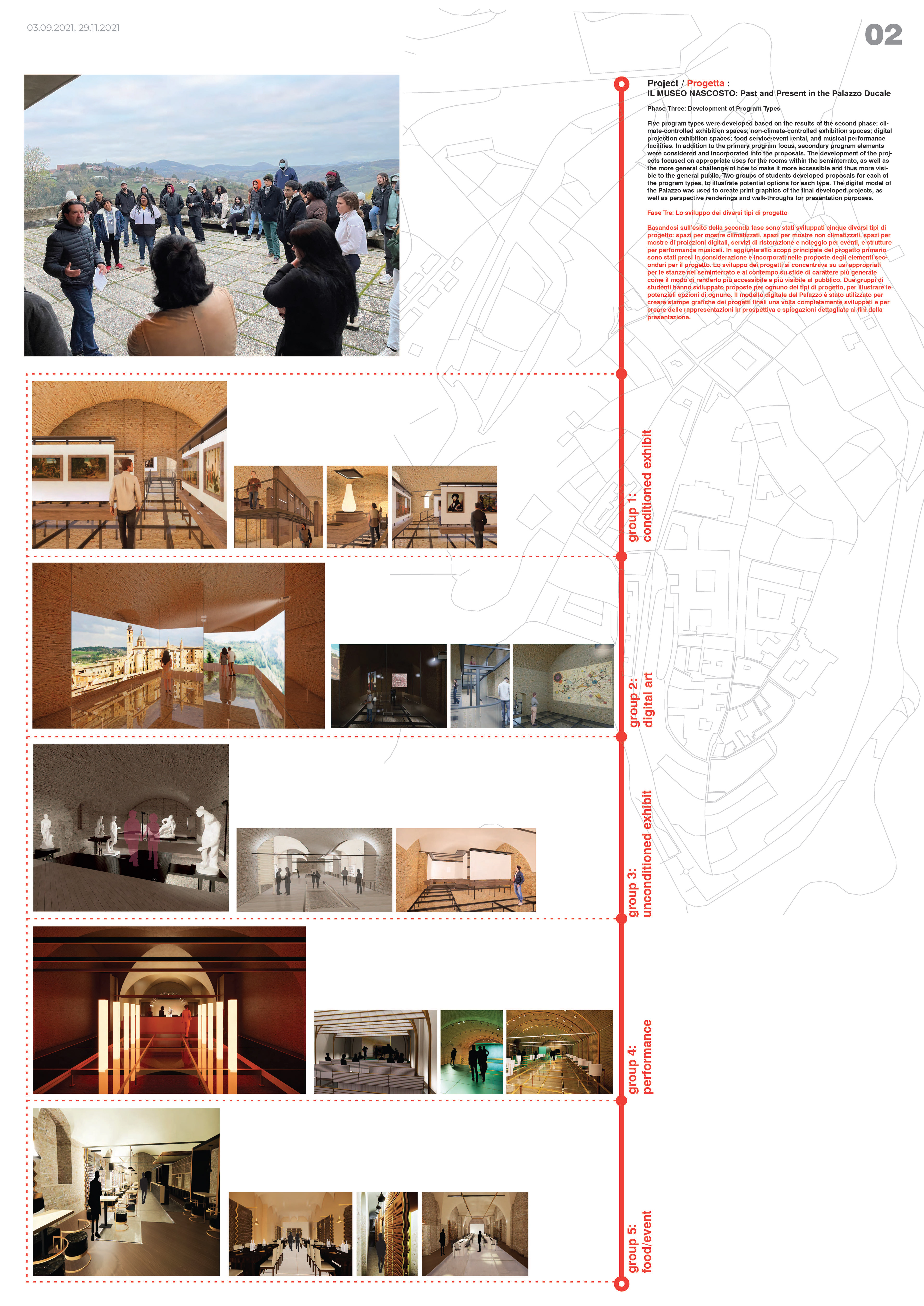
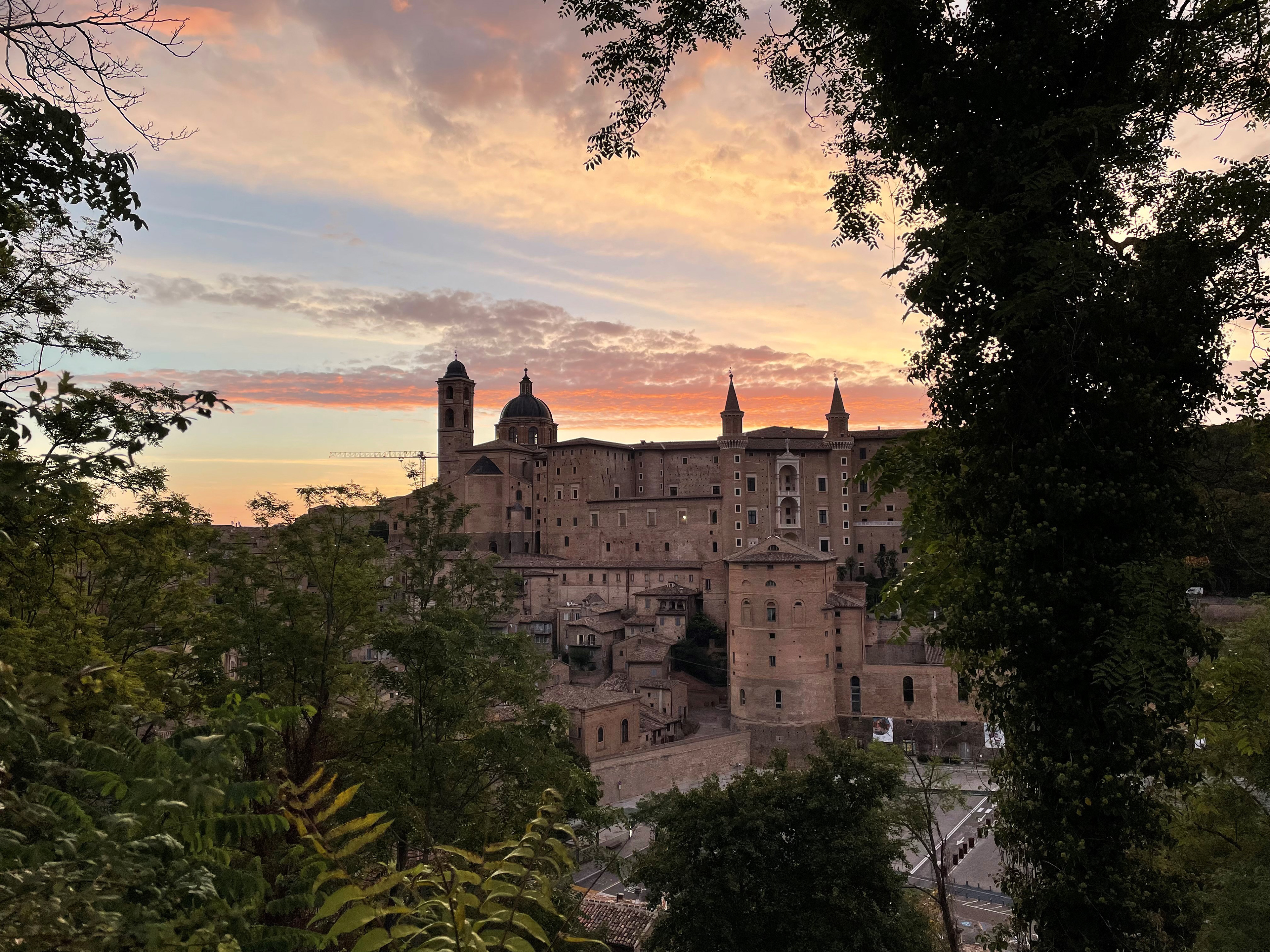
Urbino, by Darryl Ohlenbusch
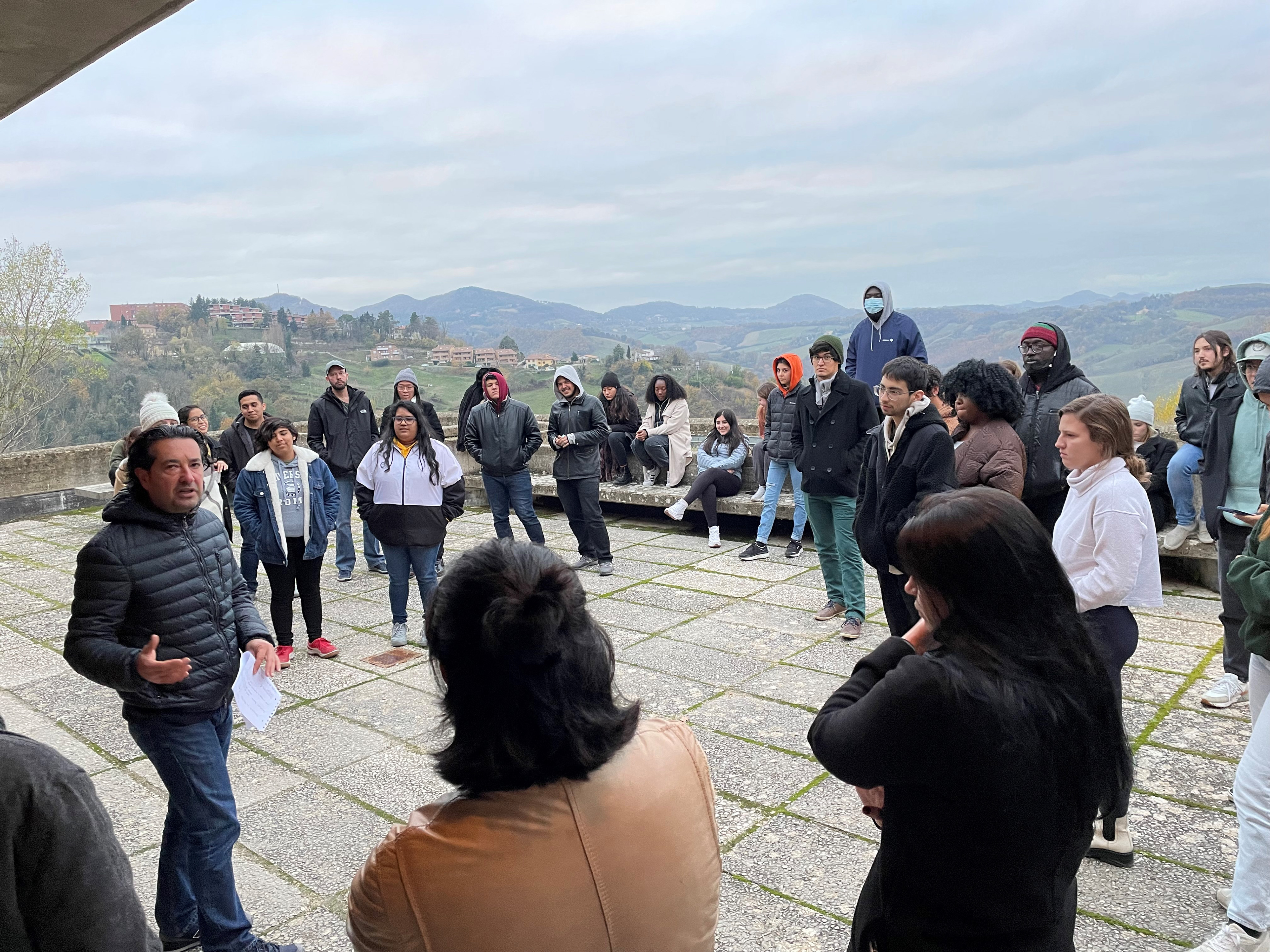
Terrazza Meeting with Mirko
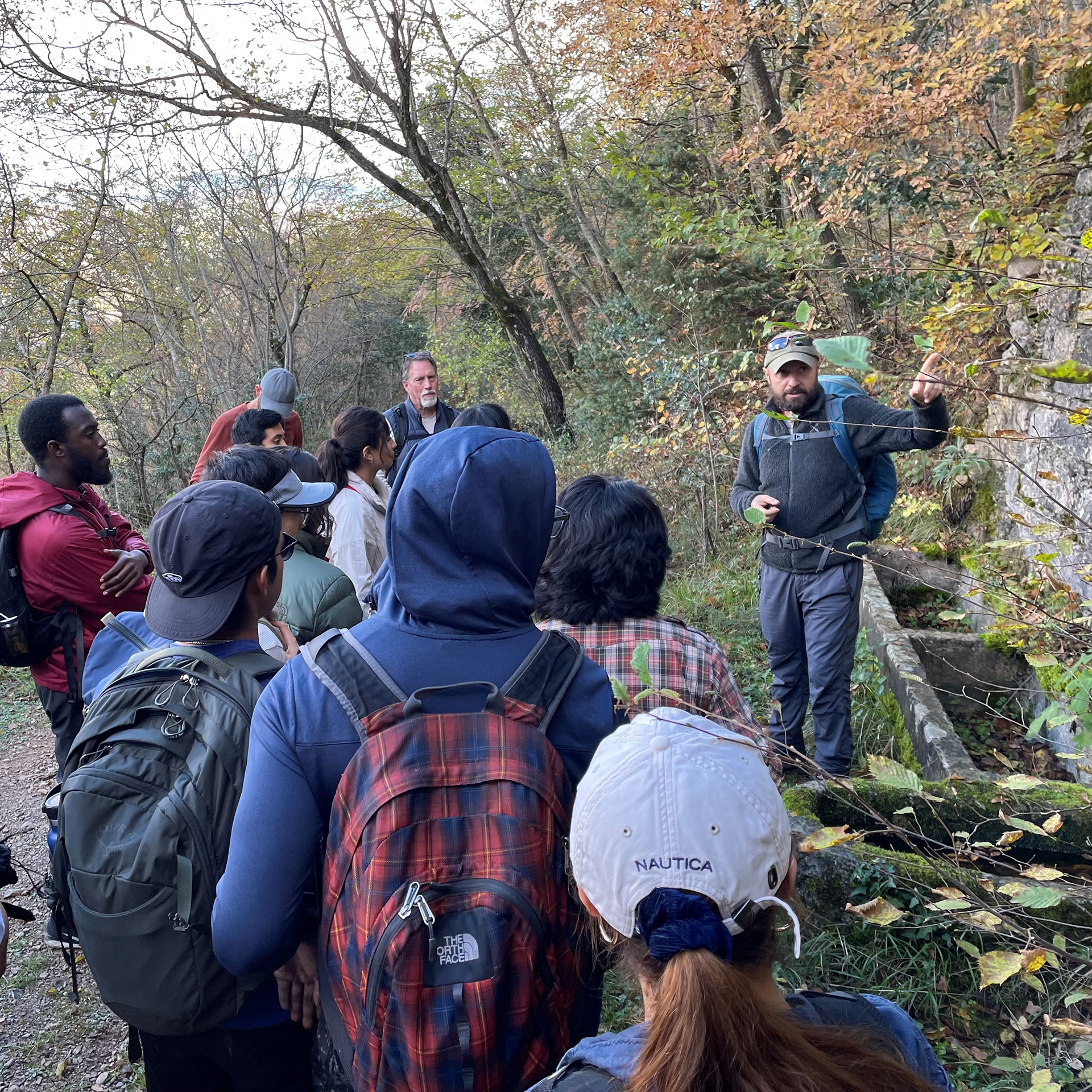
Hiking Trip in Cagli with Andrea
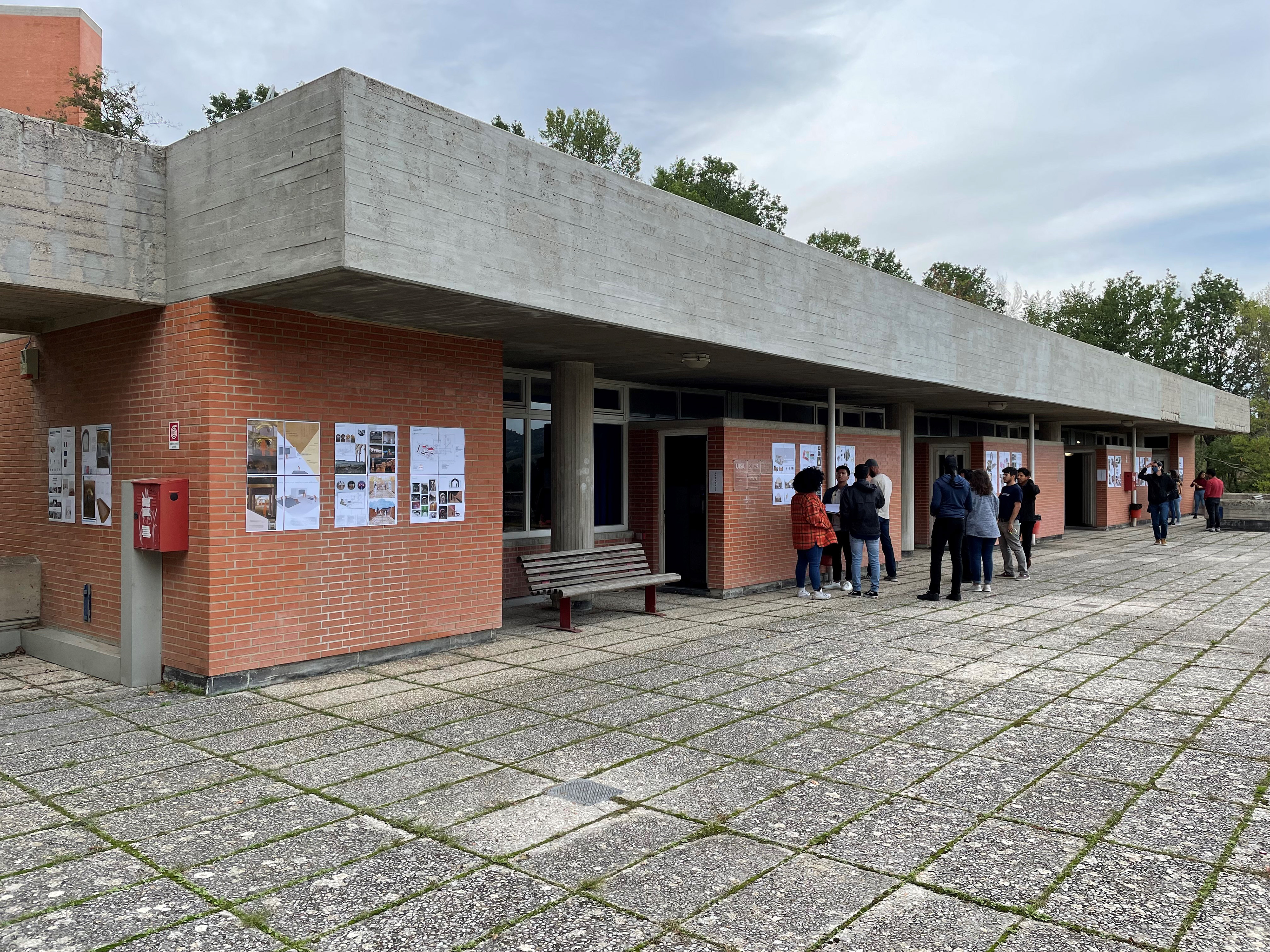
Review on the terrace with Monica Mazzolani and Antonio Troisi
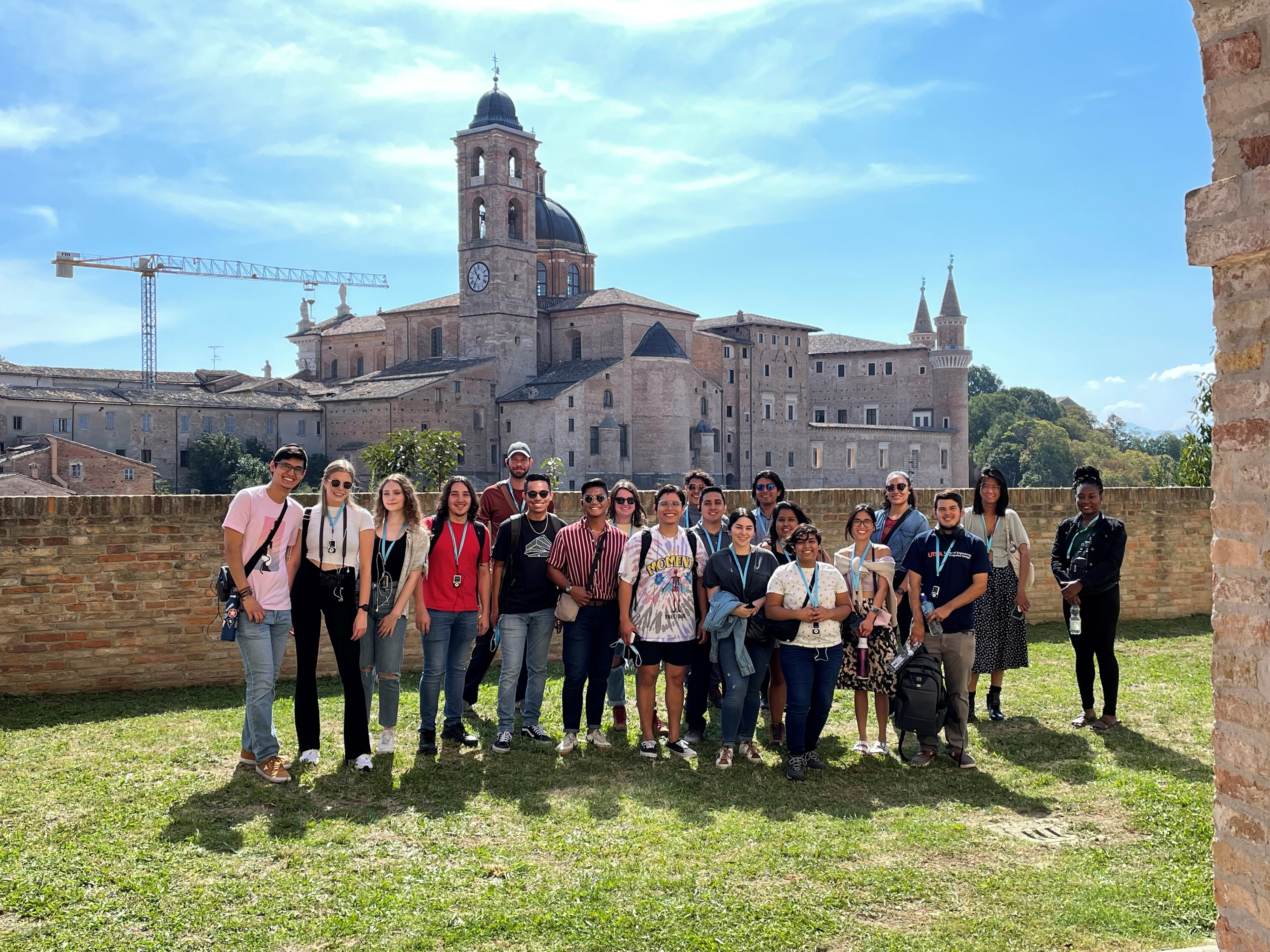
Students during their first week Urbino tour

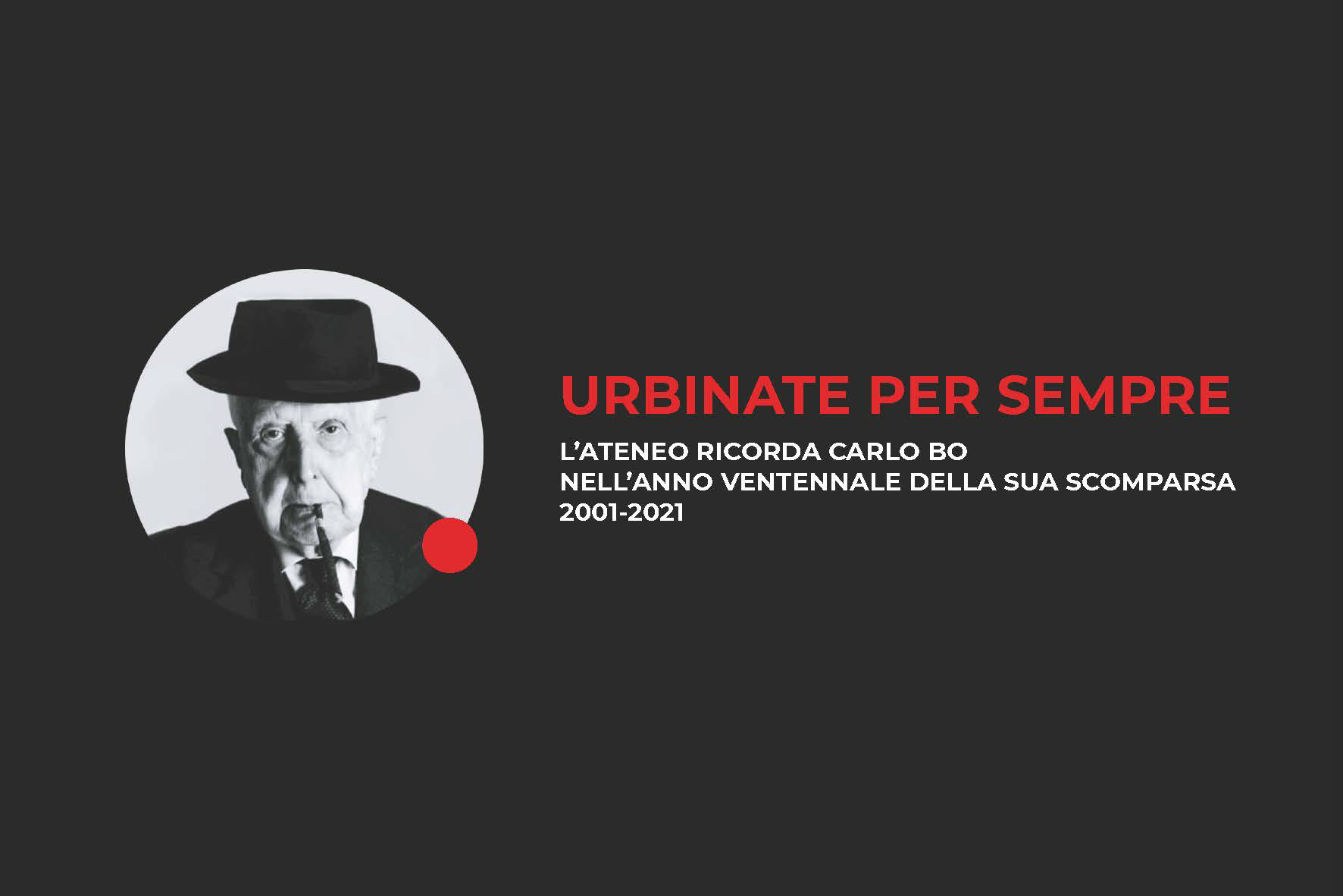
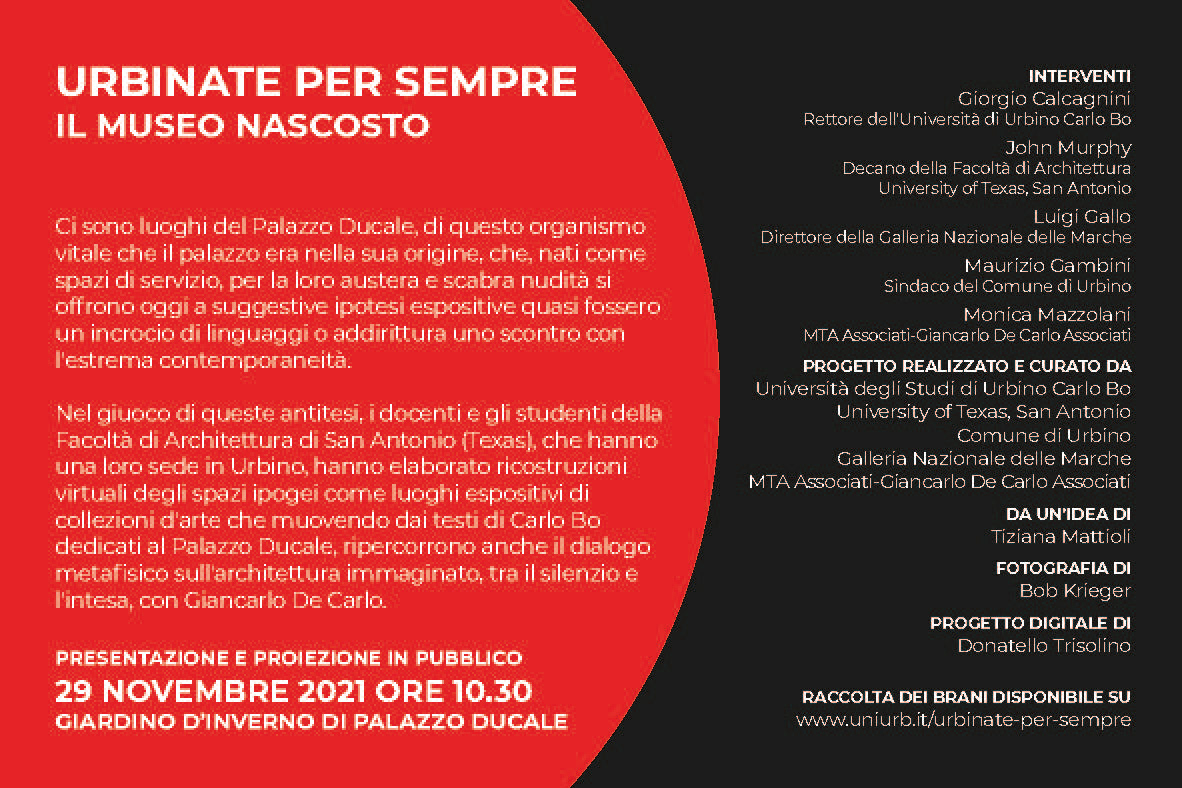



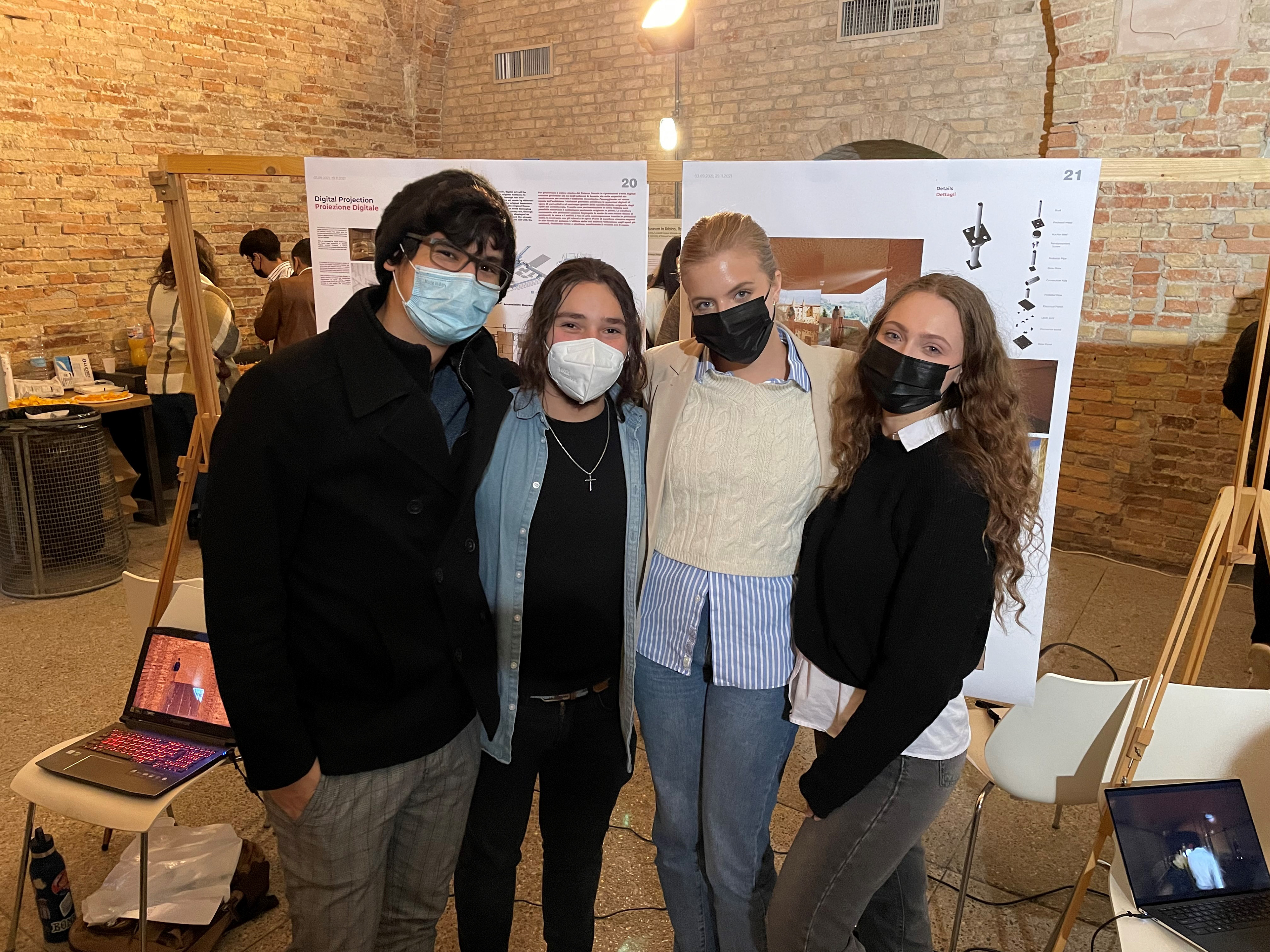
Pablo Gaytan, Carlos Hinajosa, Emily Henninger, Hayden Arkana at final presentation
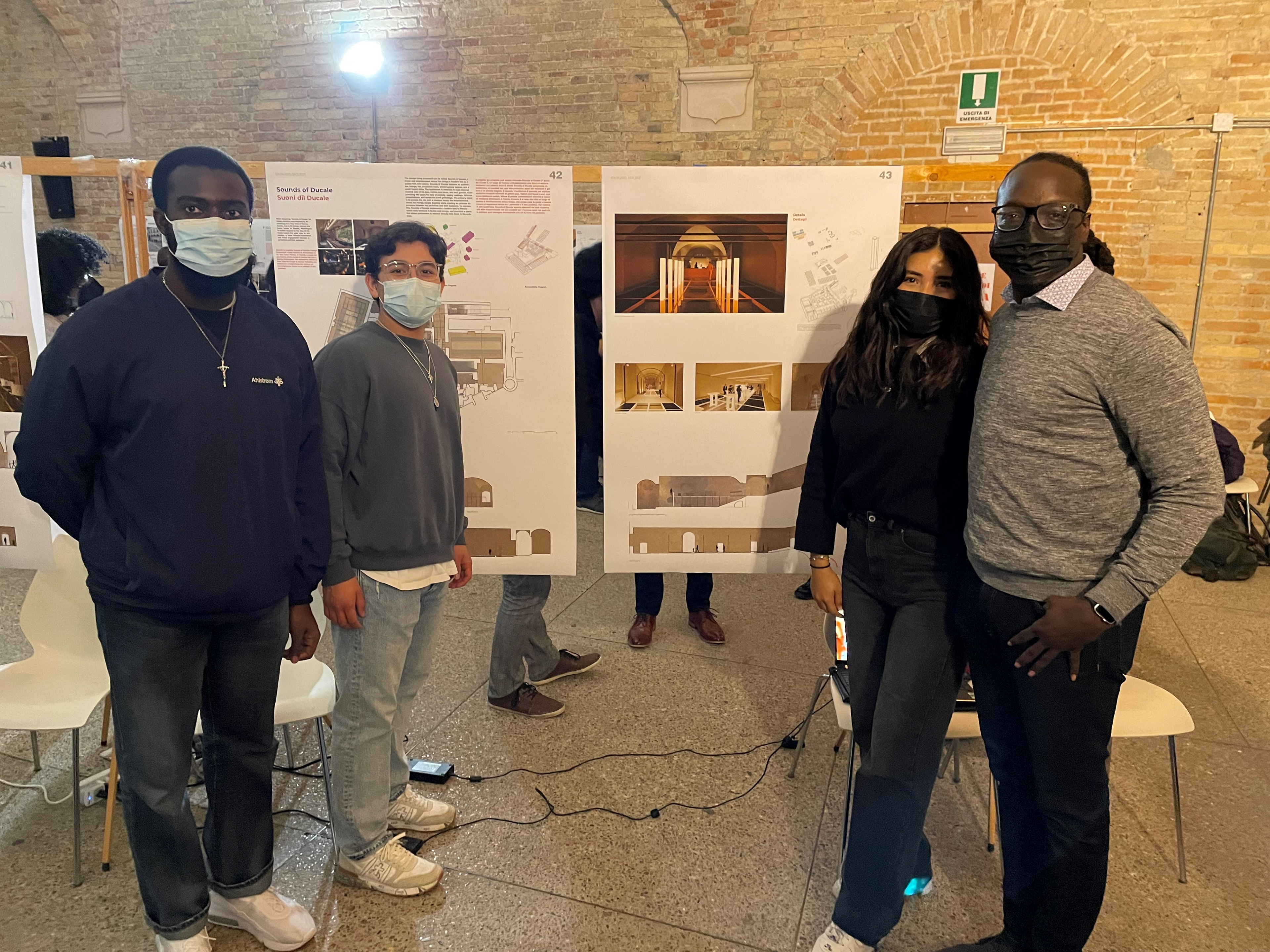
Maxwell Prempeh, Zach Balderrama, Montse Navarrete, Charles Samake
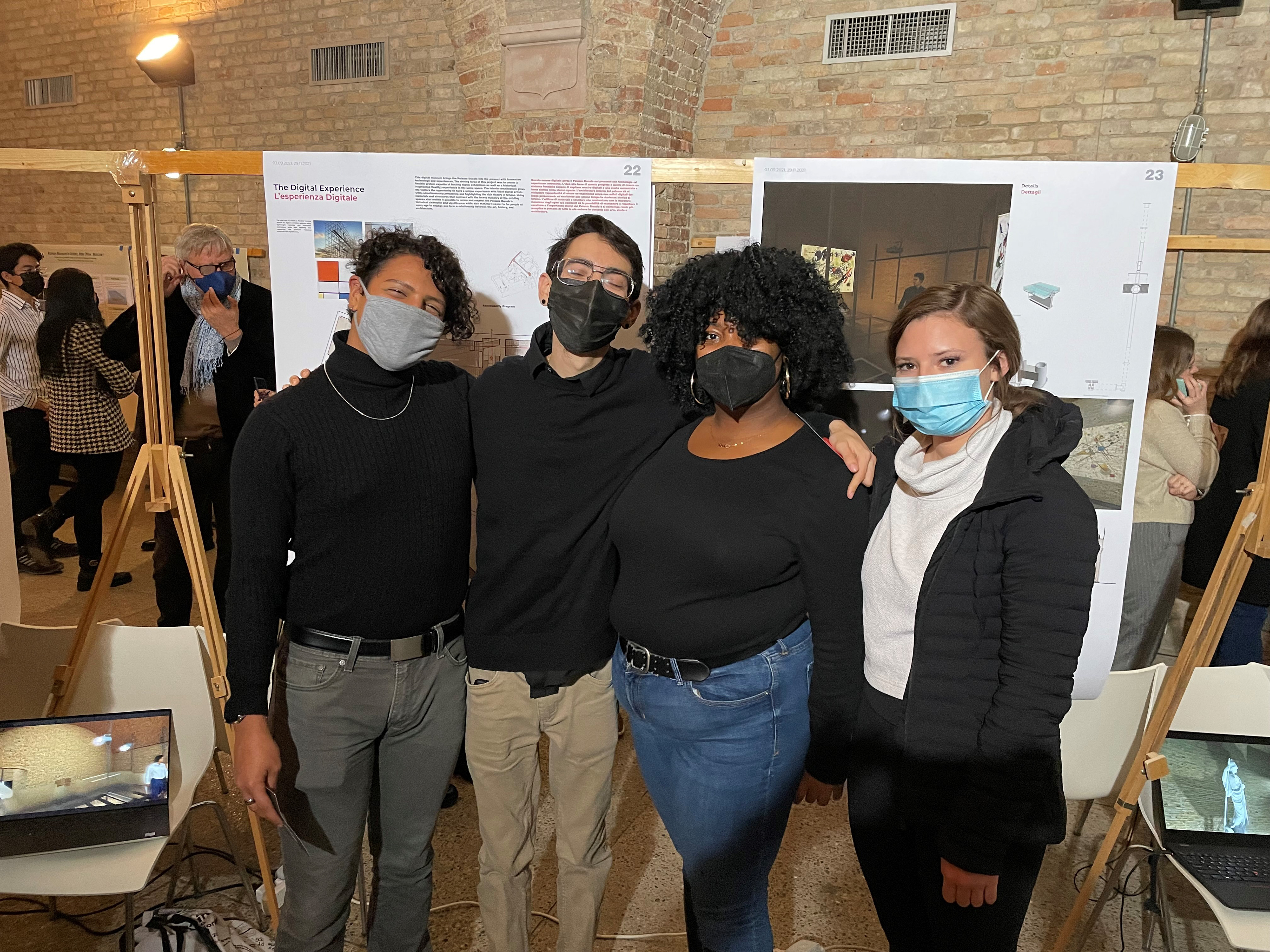
Daniel Alvarado, Ryan Rodriguez, Ariyanna Spencer, Reagan Bordovsky
Part 1: The Hidden Museum
Part 2: The Hidden Museum
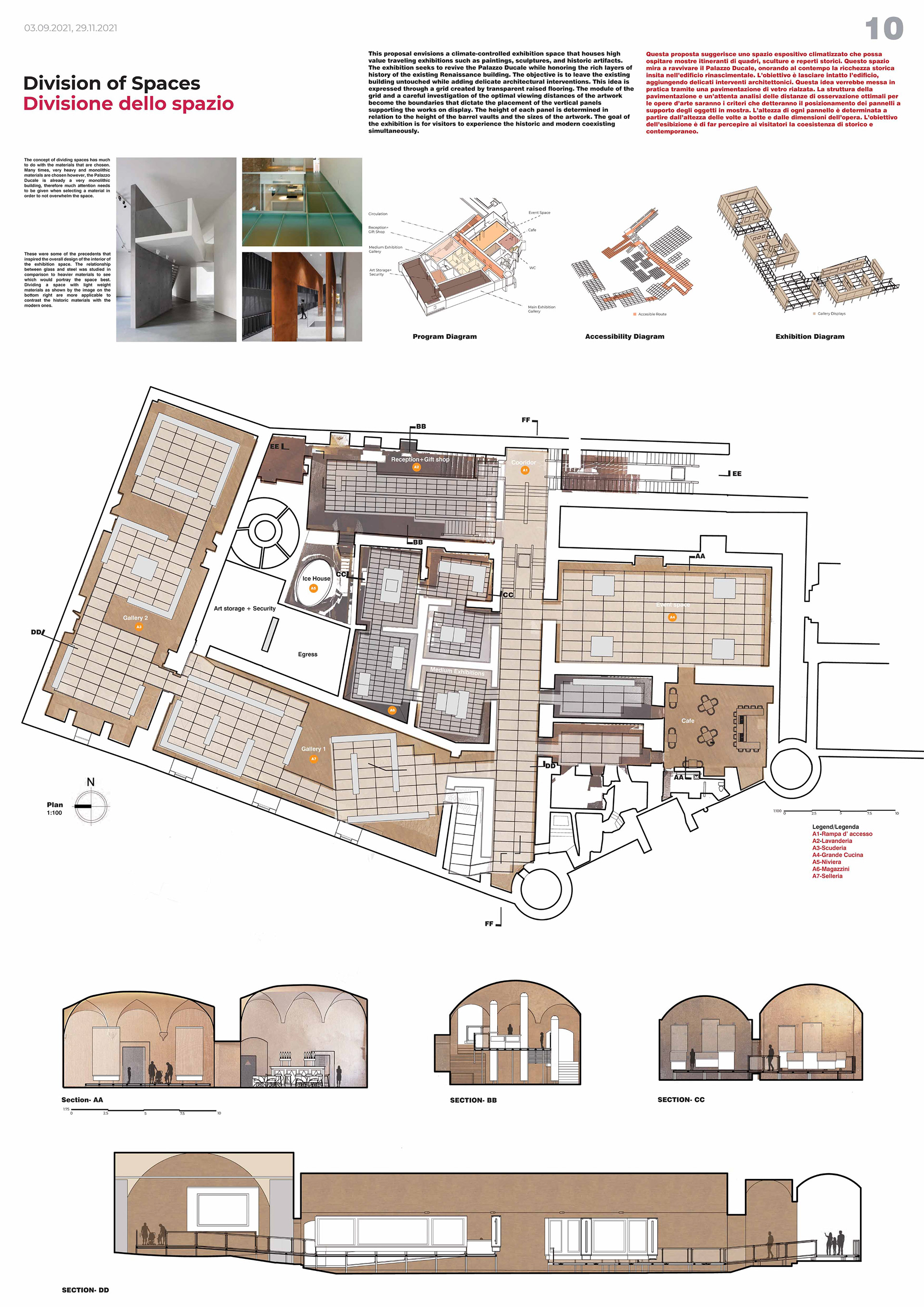
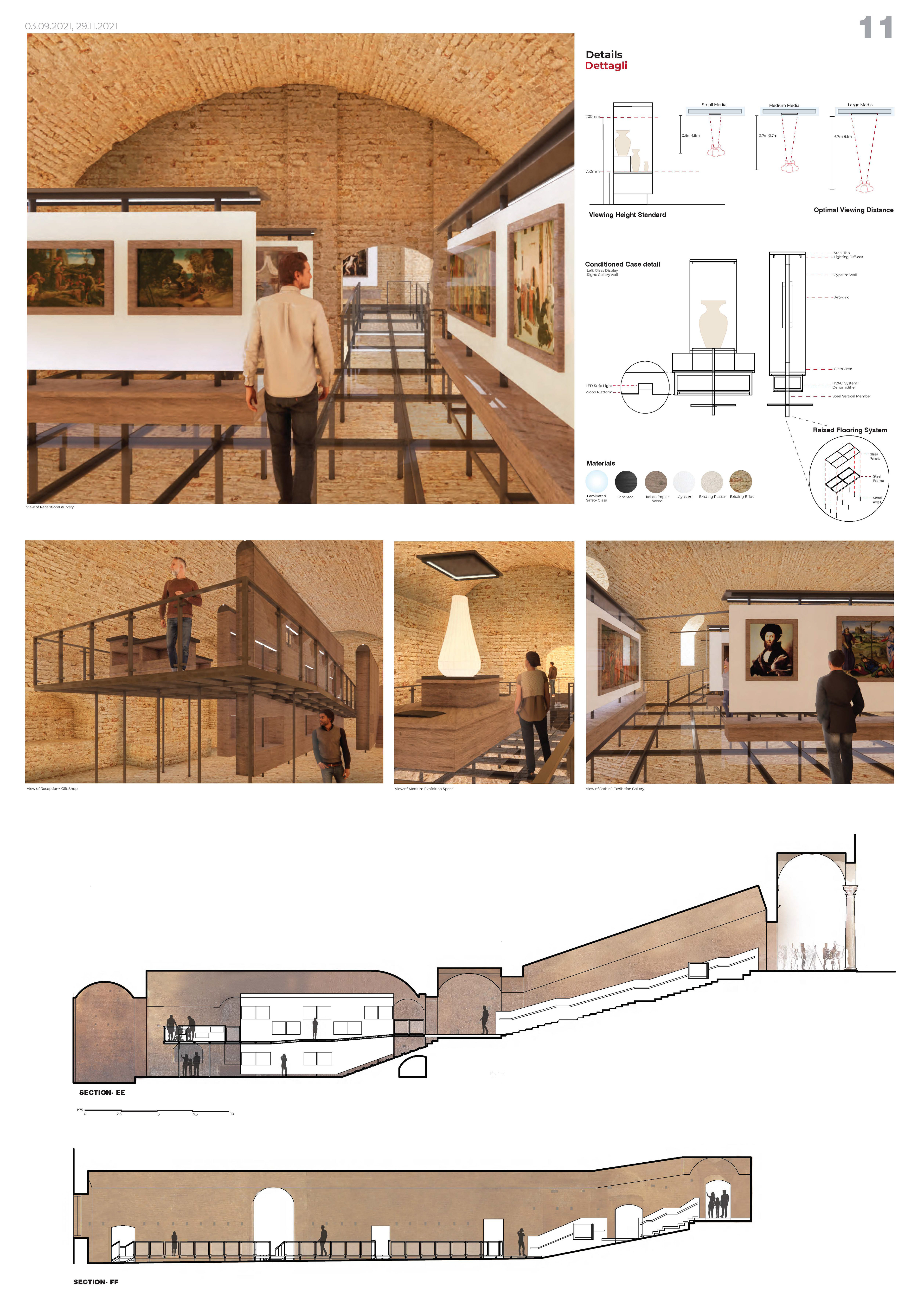
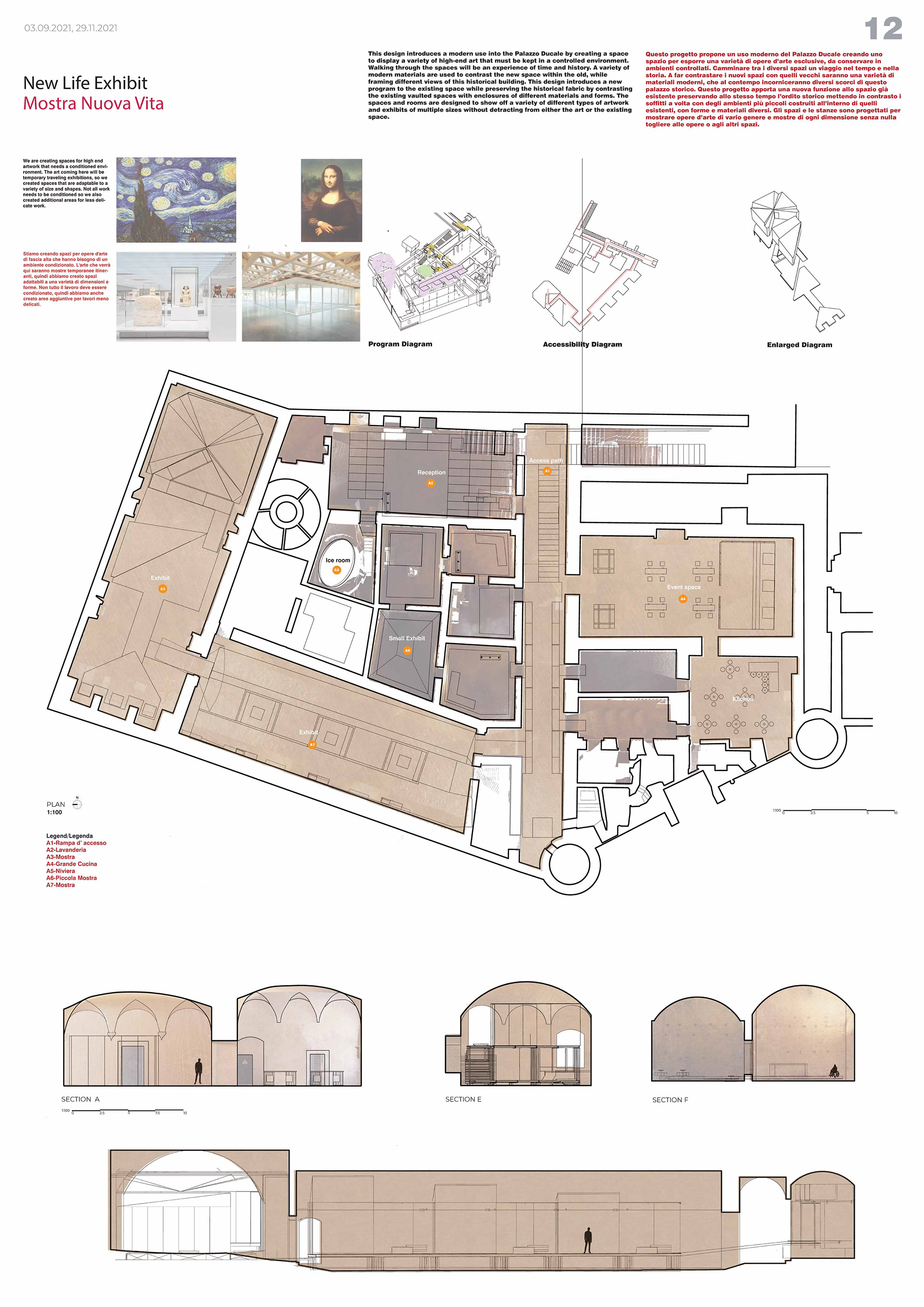
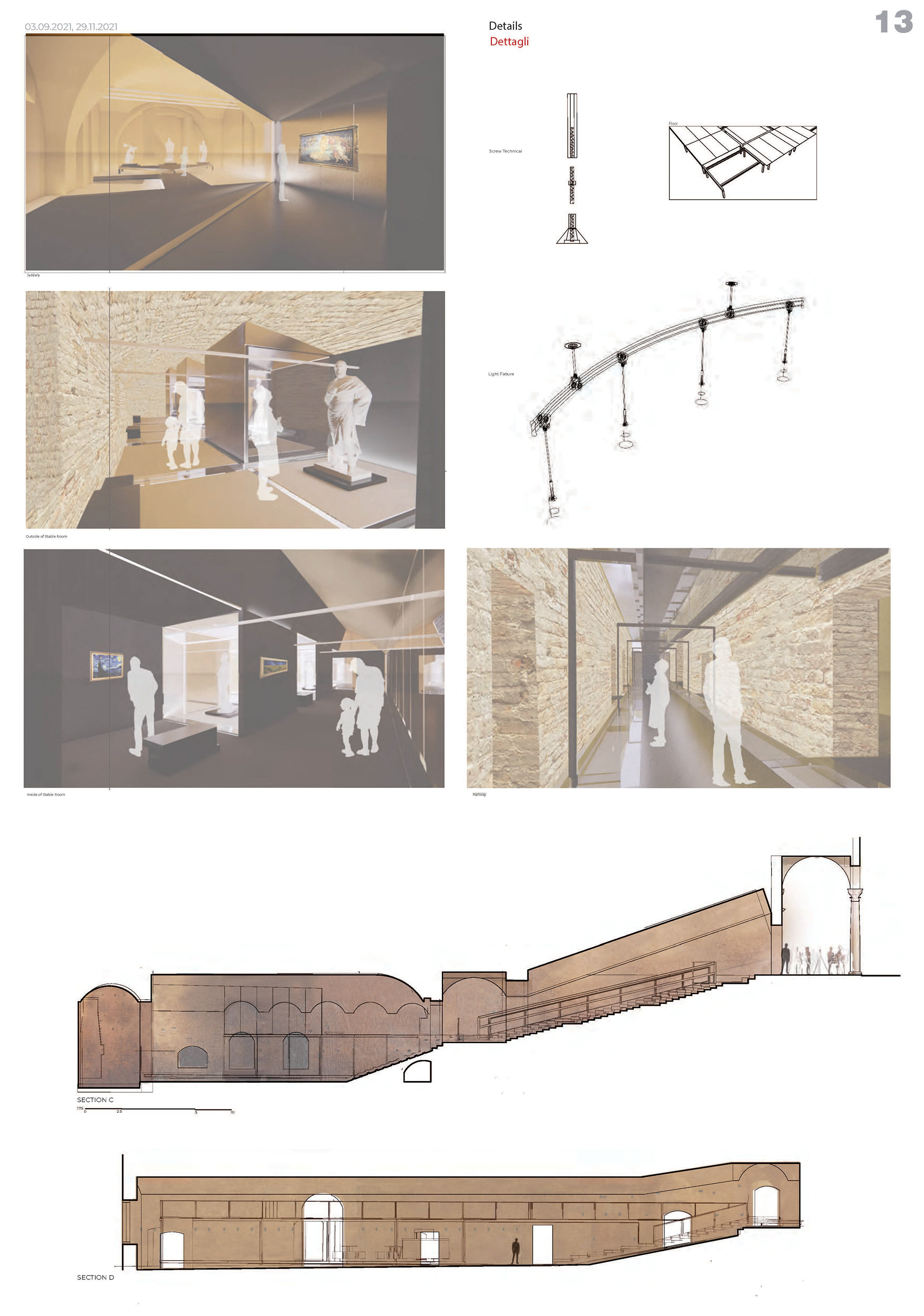
Phase One: Documentation
To produce background material necessary for the later phases of the project, and as a study of the particularities of the urban fabric of the city of Urbino, students were grouped into teams to assemble a digital model of the city based on photogrammetry from Google Earth images as well as on-site photographic documentation. Greater detail was produced for the area of the monumental center including the Duomo and Palazzo Ducale by two additional means: construction of the buildings in Revit largely on the basis of the 1985 drawings of the Palazzo by Spiridione Alessandro Curuni, and new laser scans of the ‘seminterrato’ basement level of the Palazzo produced by Giovanni Checcucci in September 2021. The resultant model provides a basis for the present design project, and can be augmented in the future by similar documentation efforts.
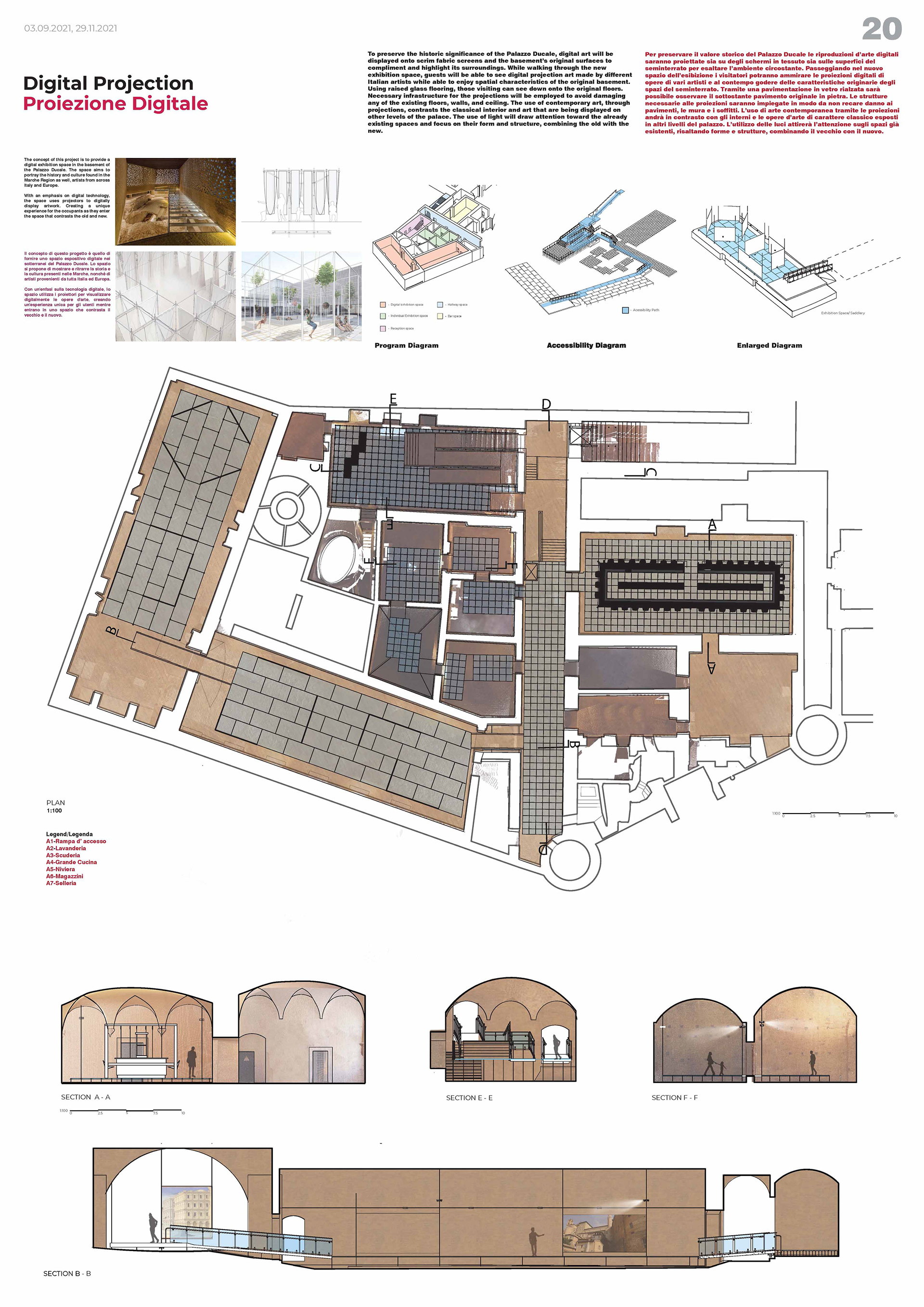
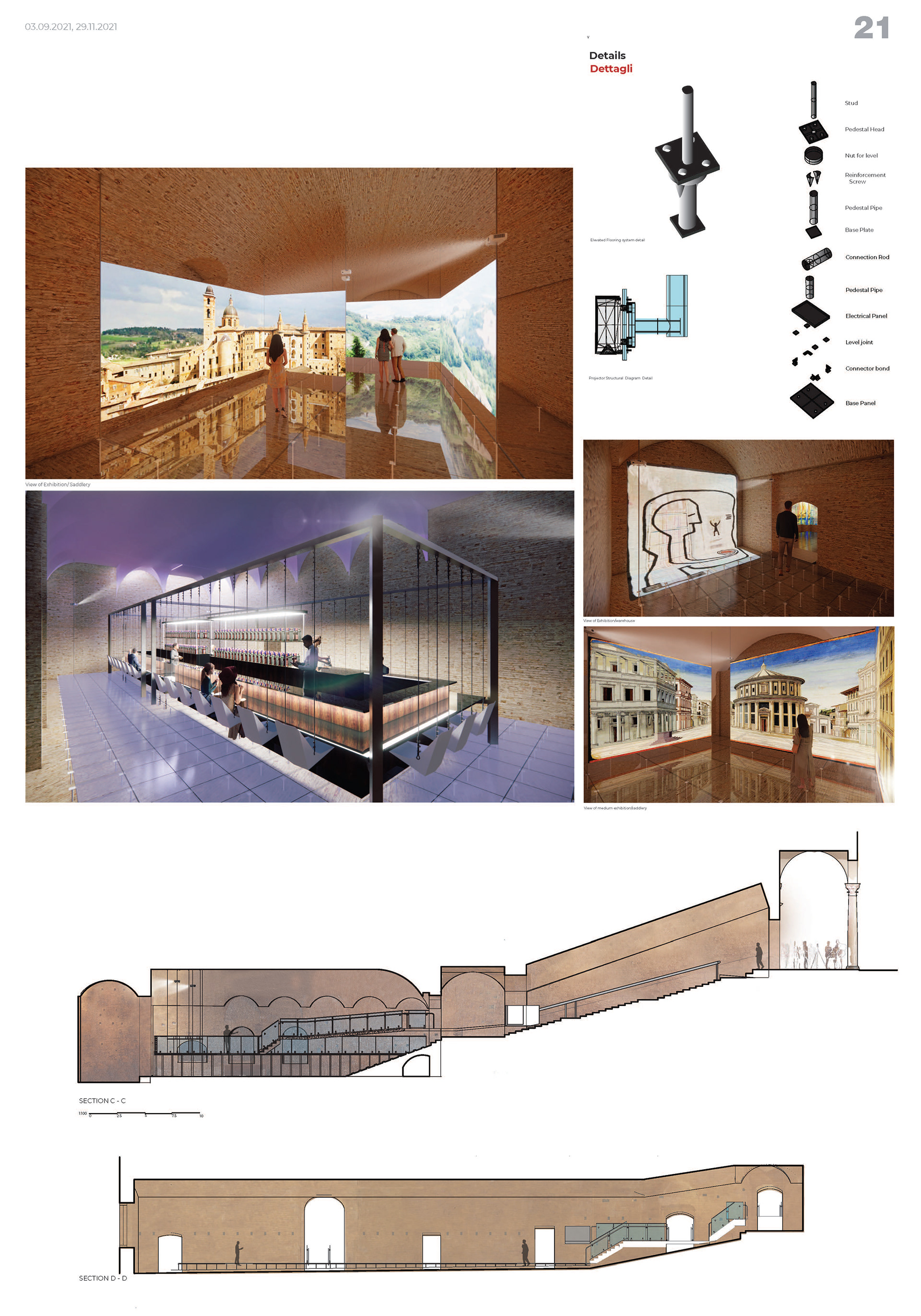
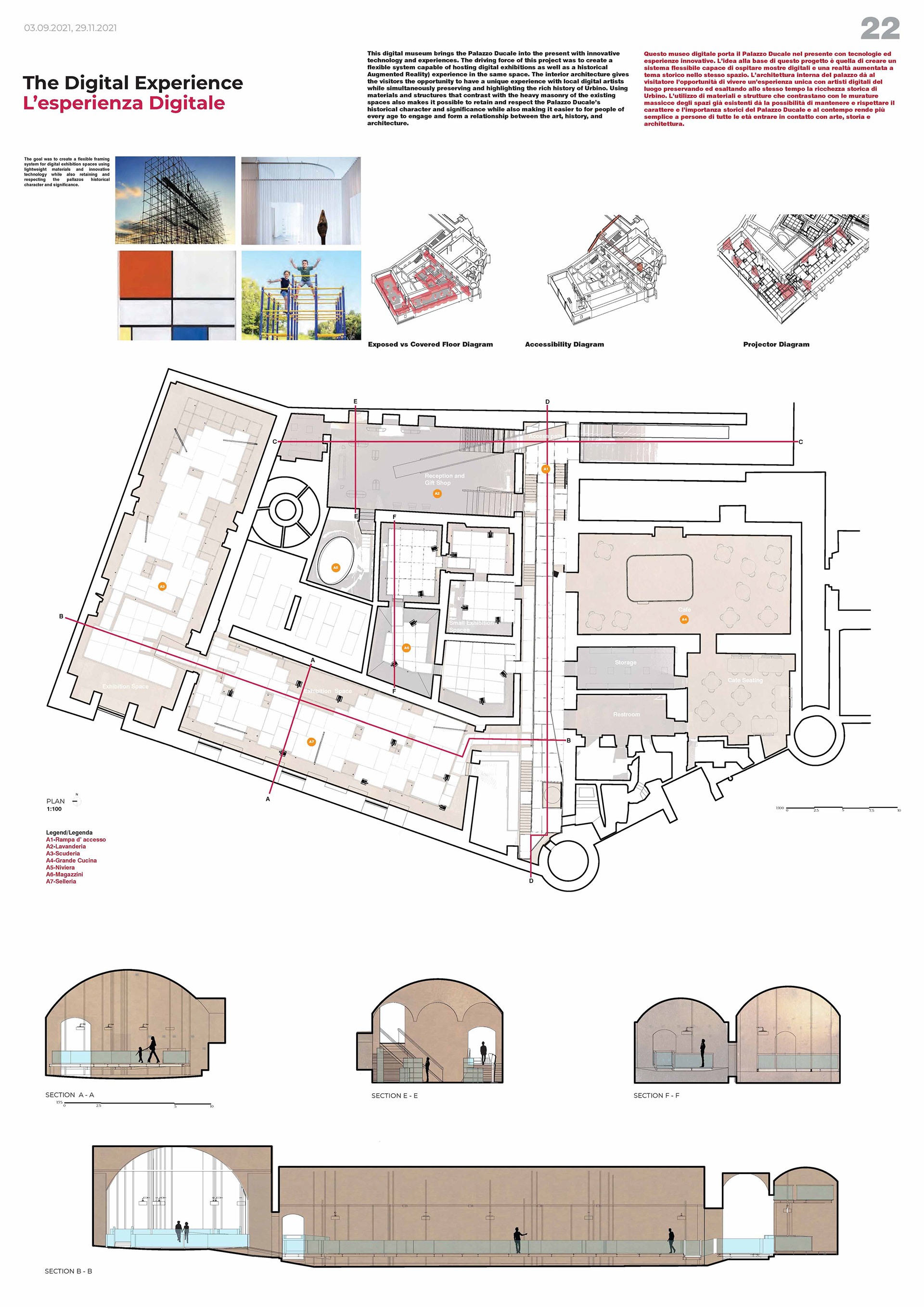
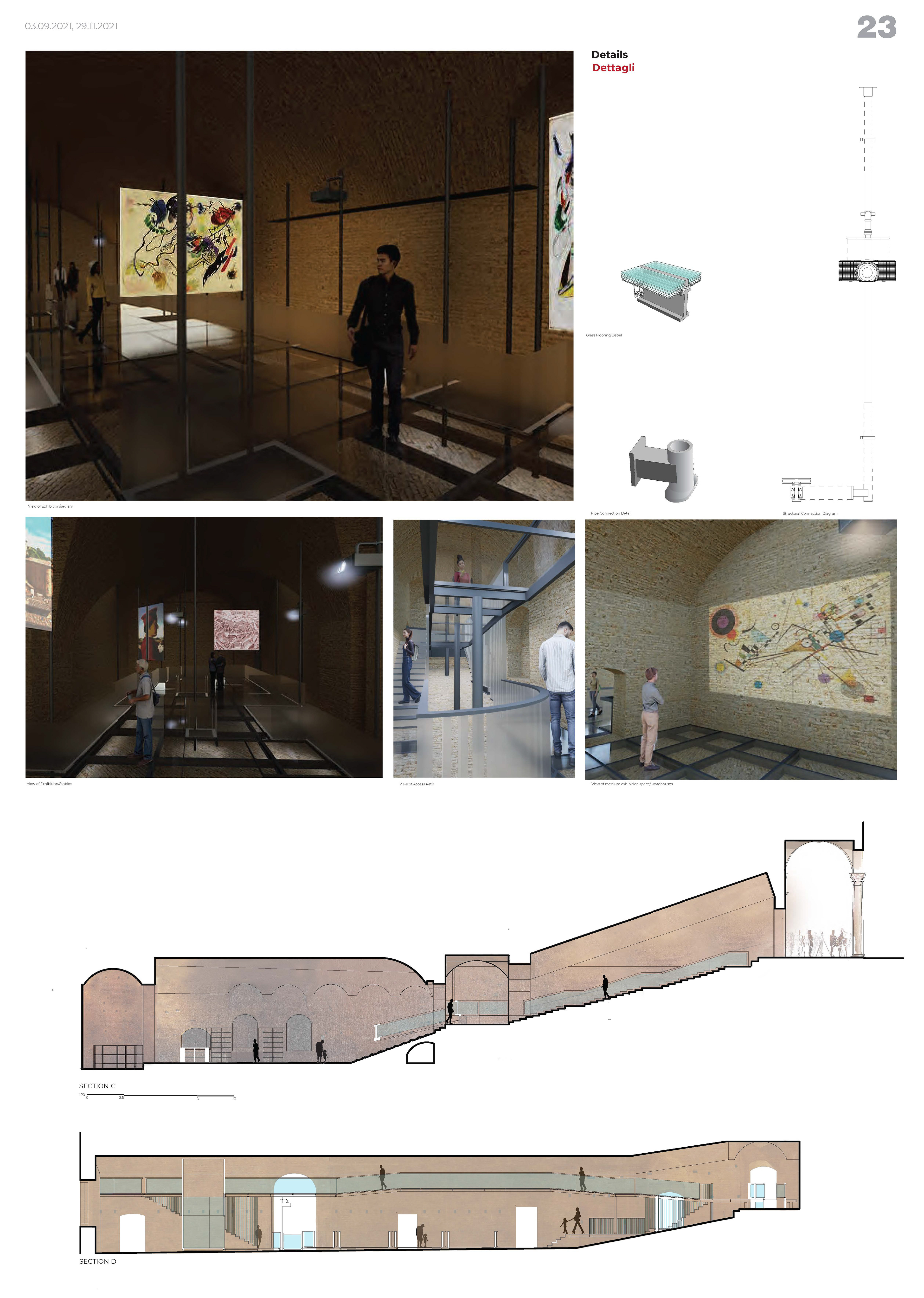
Phase Two: Ideation of Program
The initial design phase involved groups of students freely proposing uses for the basement level of the Palazzo, considering issues of historical context, spatial typology and climate-control challenges. The resulting ideas ranged from new program ideas such as exhibition and performance spaces, to the re-creation of historic uses in the seminterrato, including returning horses to the stables as part of an equestrian center. These proposals were vetted by the course instructors and also guest reviewers Monica Mazzolani and Antonio Troisi, with the intent of discerning which ideas seemed most appropriate and thus should be carried forward into the final phase.
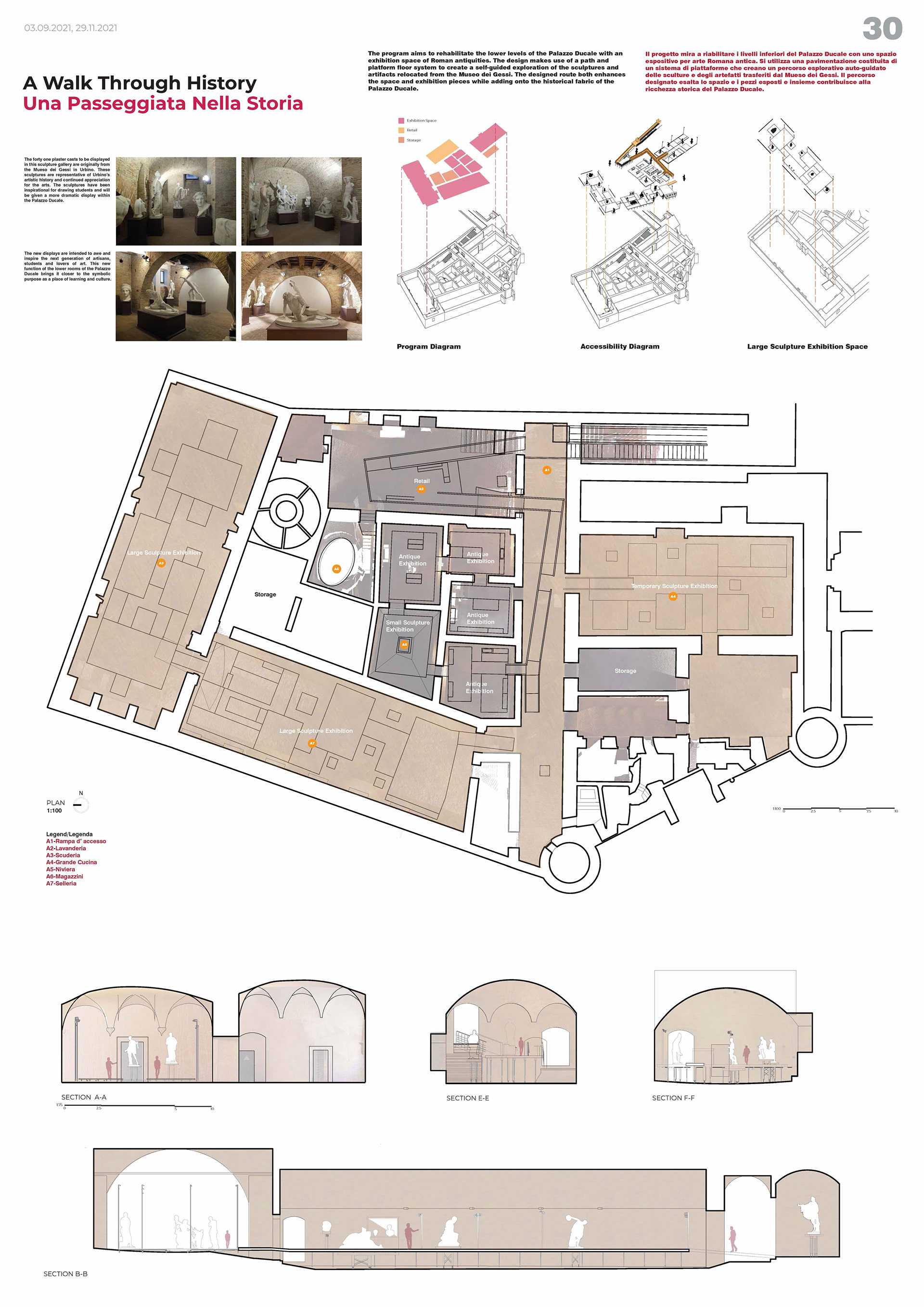
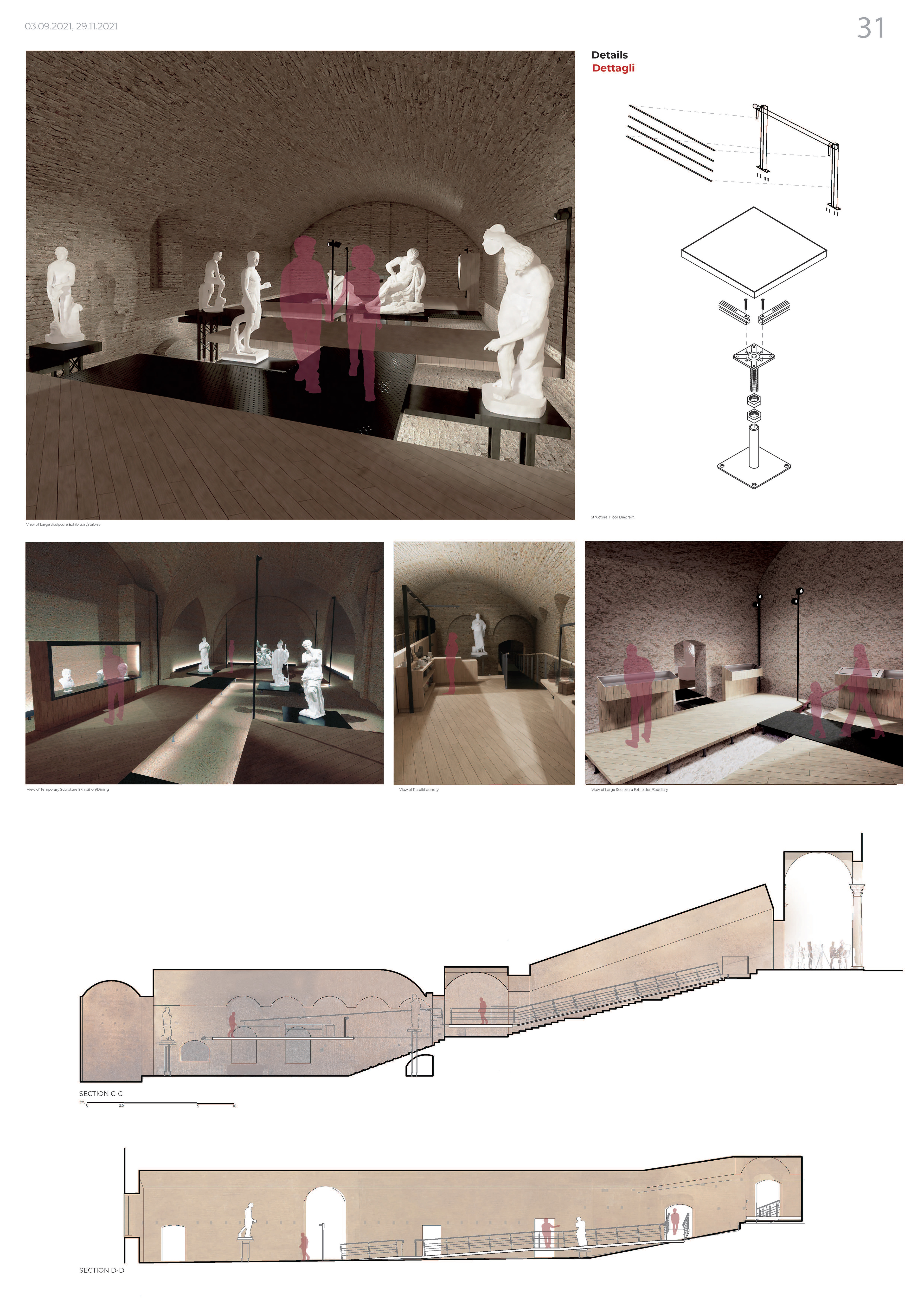
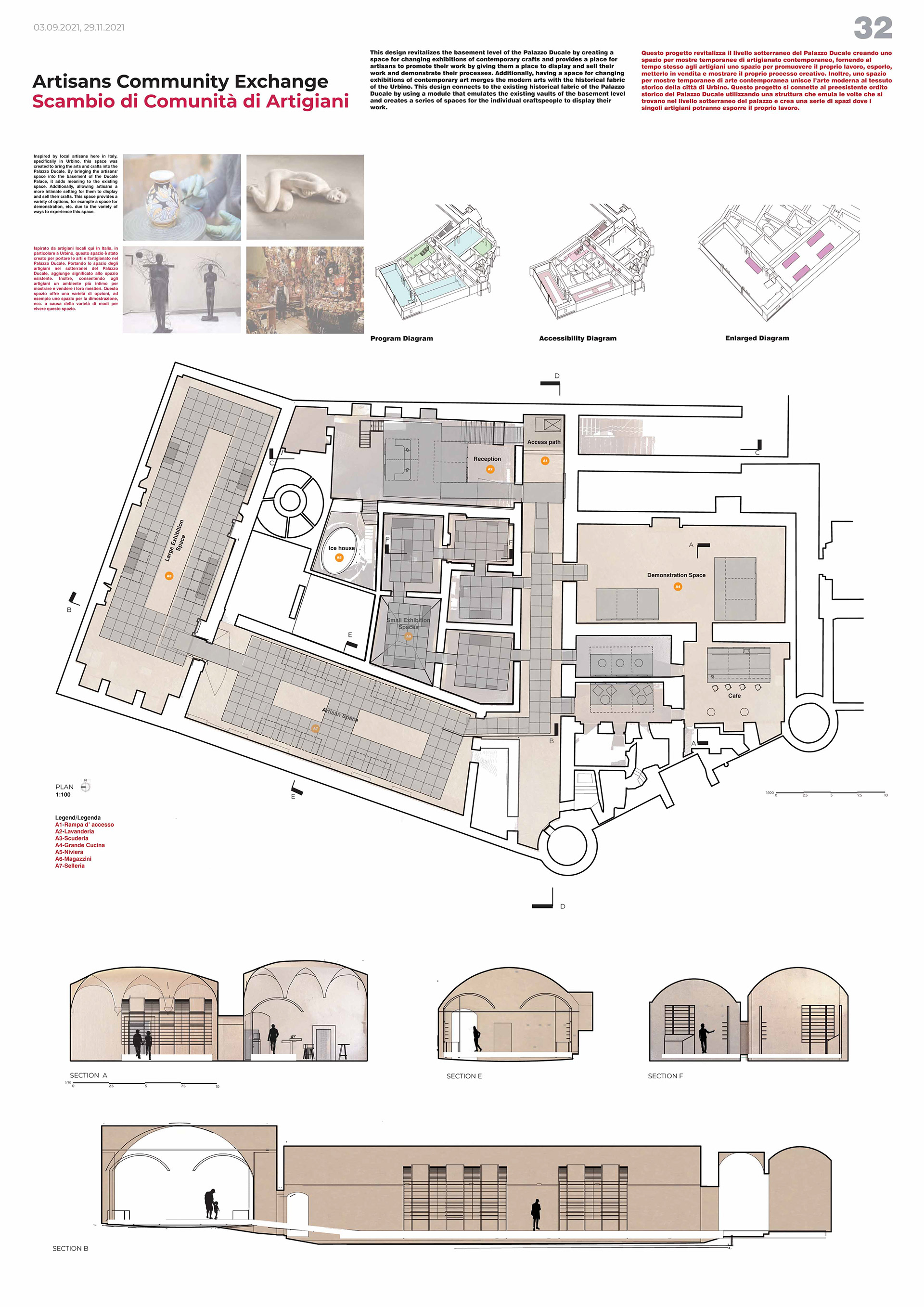
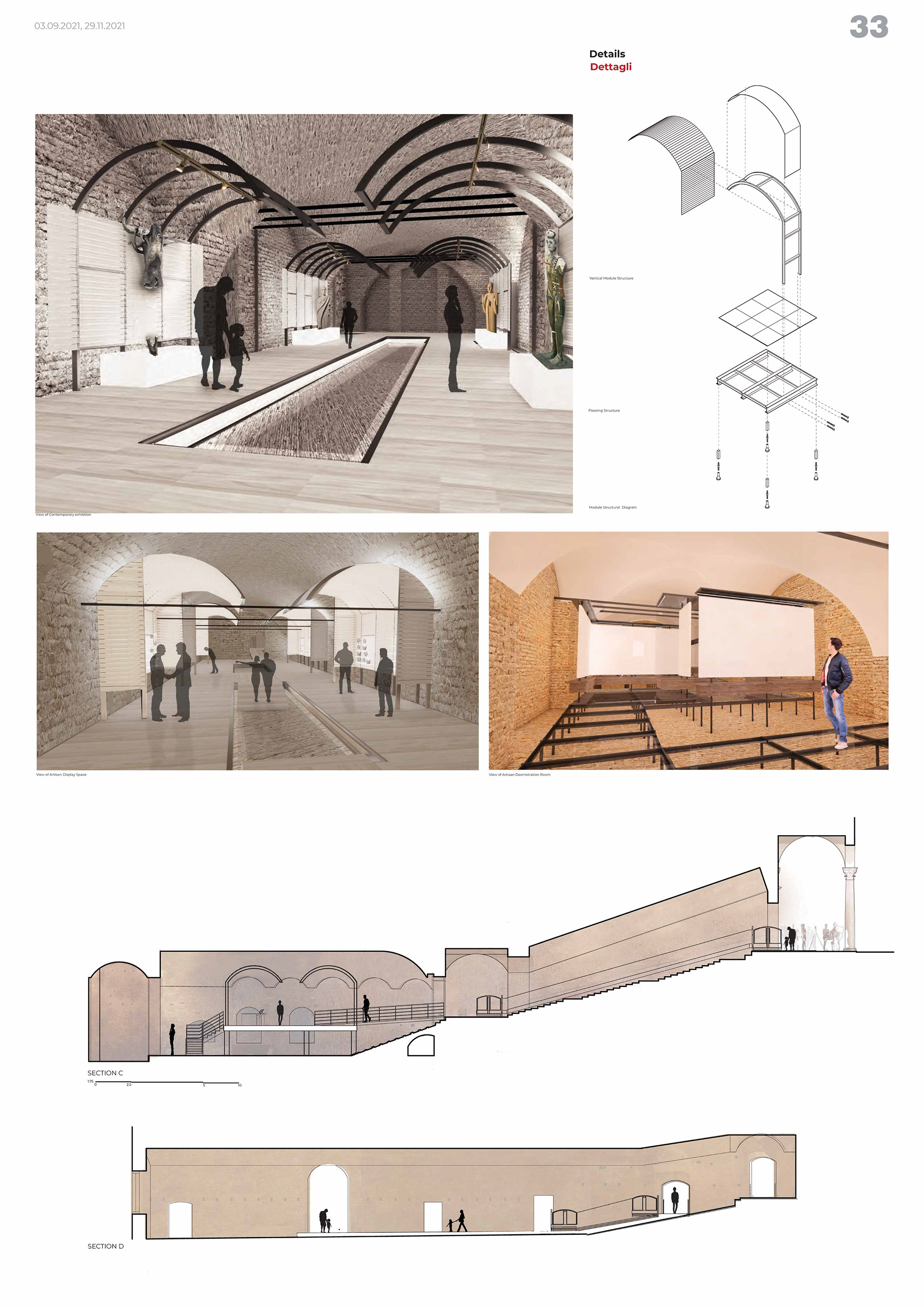
Phase Three: Development of Program Types
Five program types were developed based on the results of the second phase: climate-controlled exhibition spaces; non-climate-controlled exhibition spaces; digital projection exhibition spaces; food service/event rental, and musical performance facilities. In addition to the primary program focus, secondary program elements were considered and incorporated into the proposals. The development of the projects focused on appropriate uses for the rooms within the seminterrato, as well as the more general challenge of how to make it more accessible and thus more visible to the general public. Two groups of students developed proposals for each of the program types, to illustrate potential options for each type. The digital model of the Palazzo was used to create print graphics of the final developed projects, as well as perspective renderings and walk-throughs for presentation purposes.
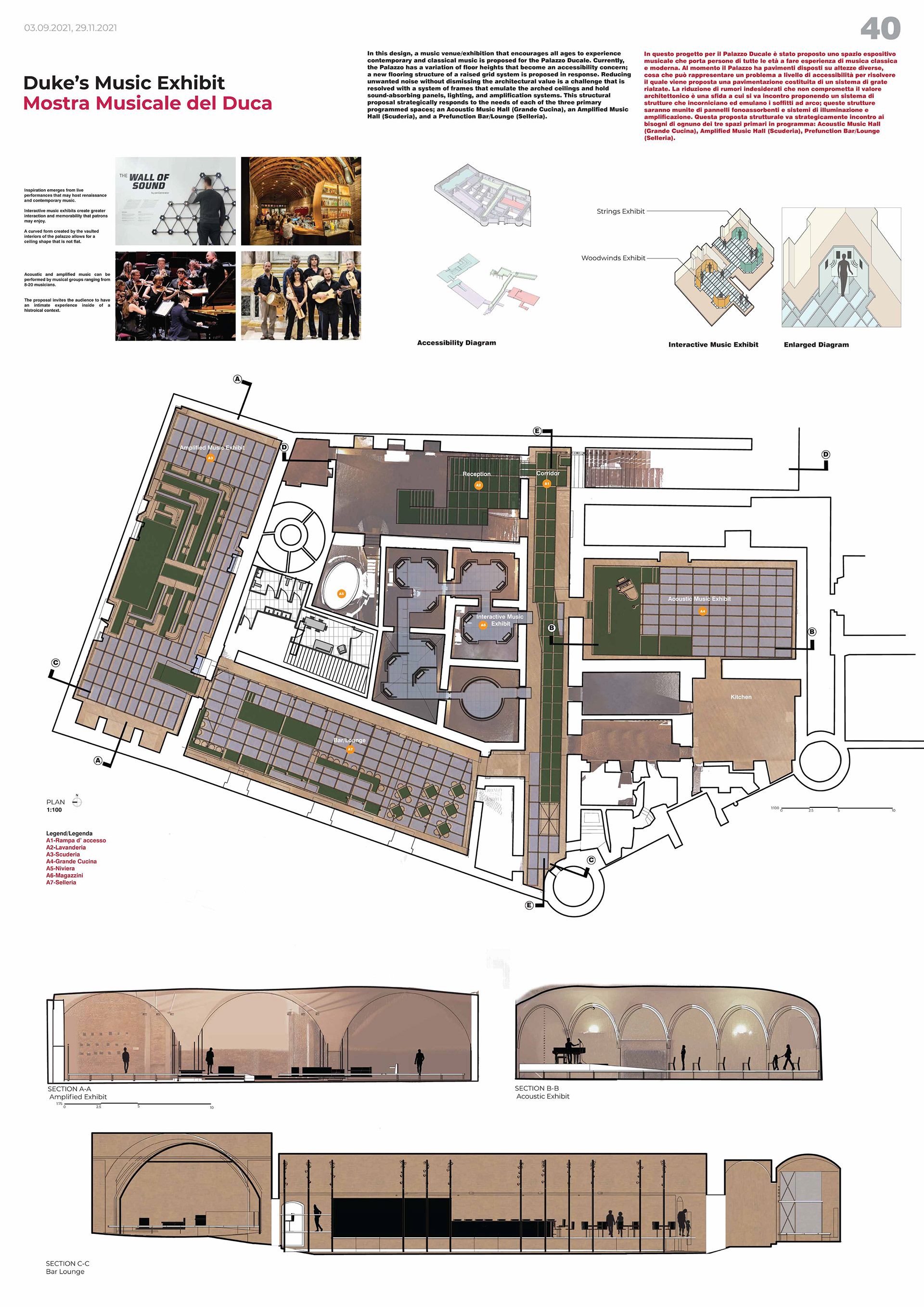
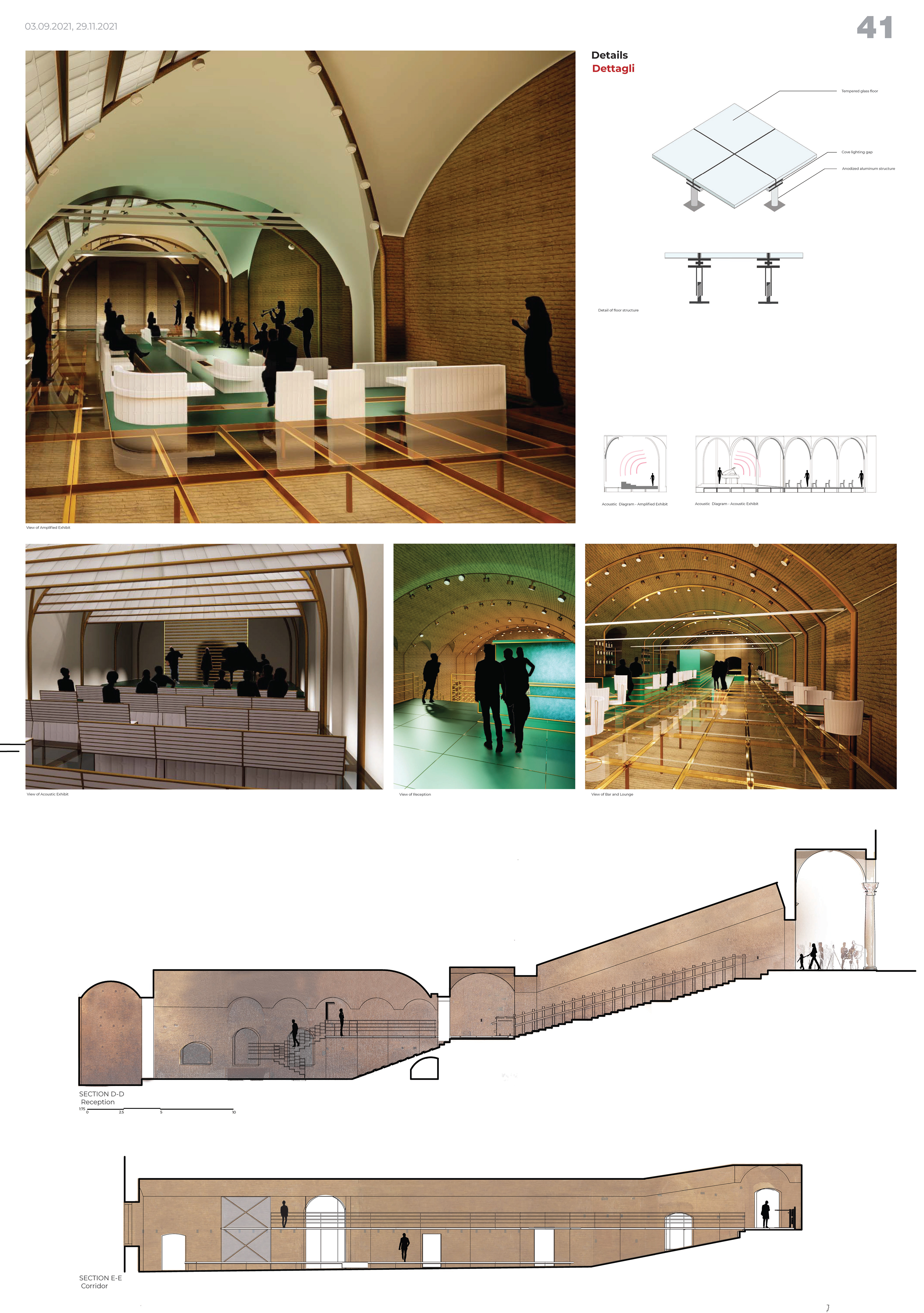
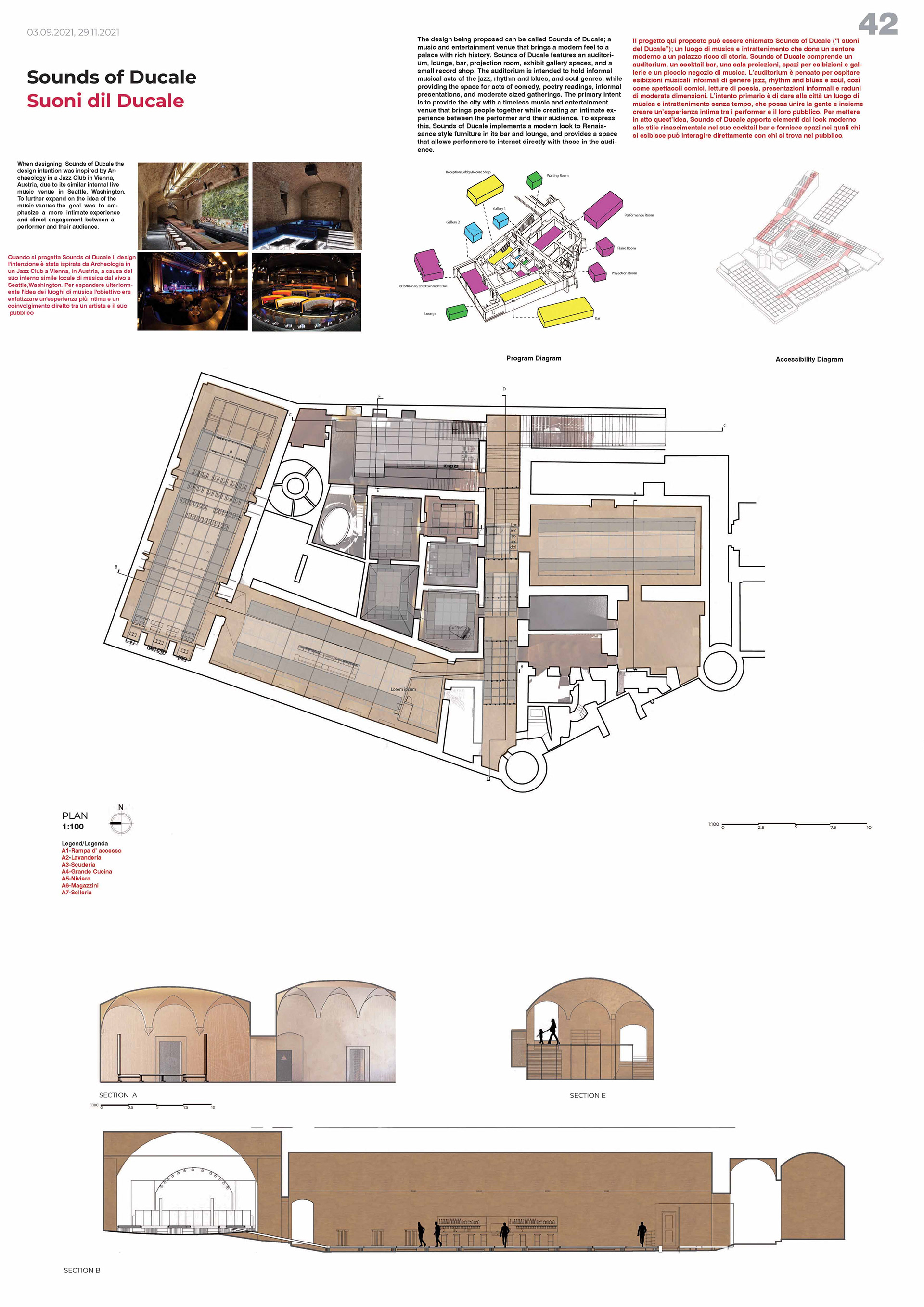
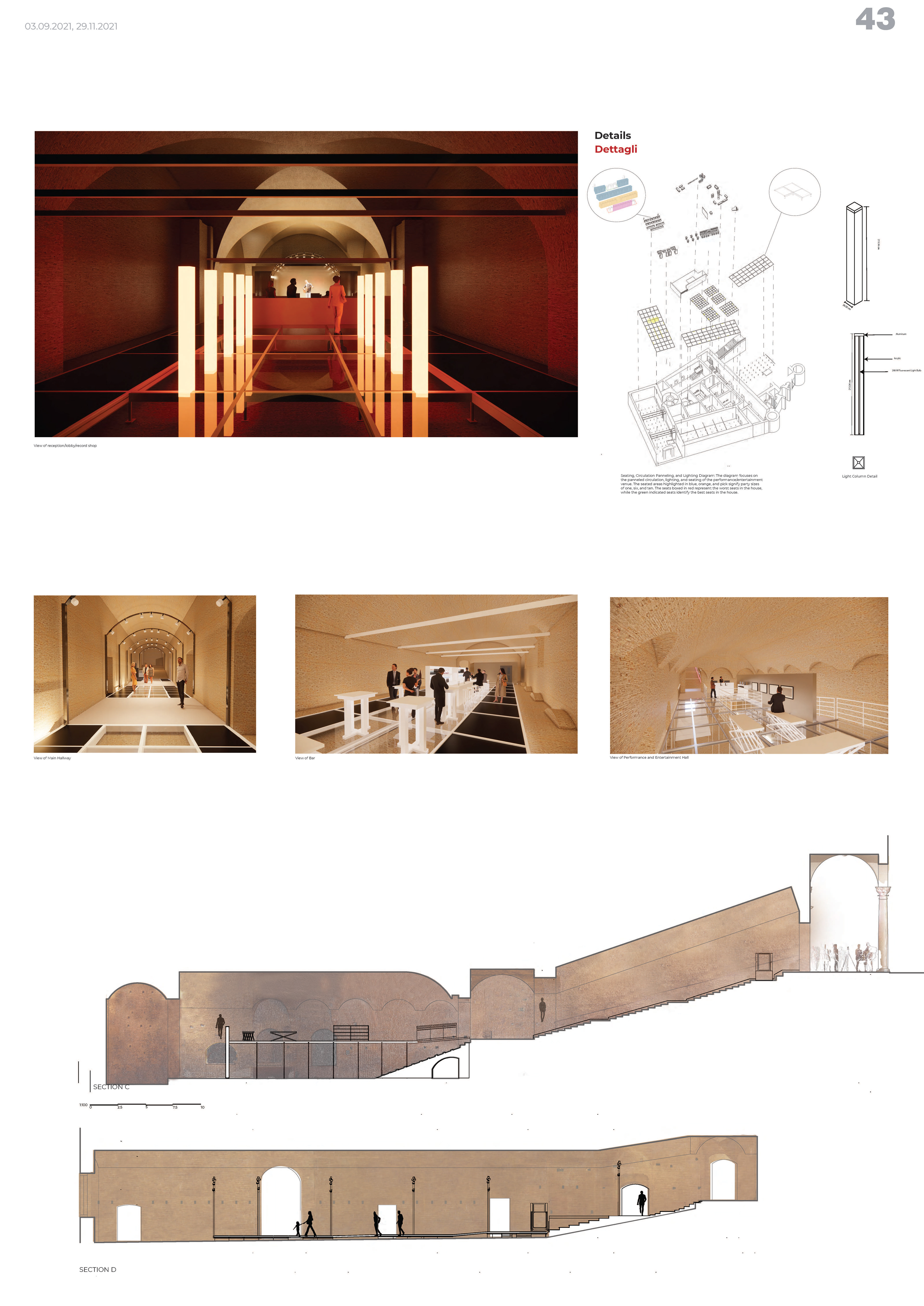
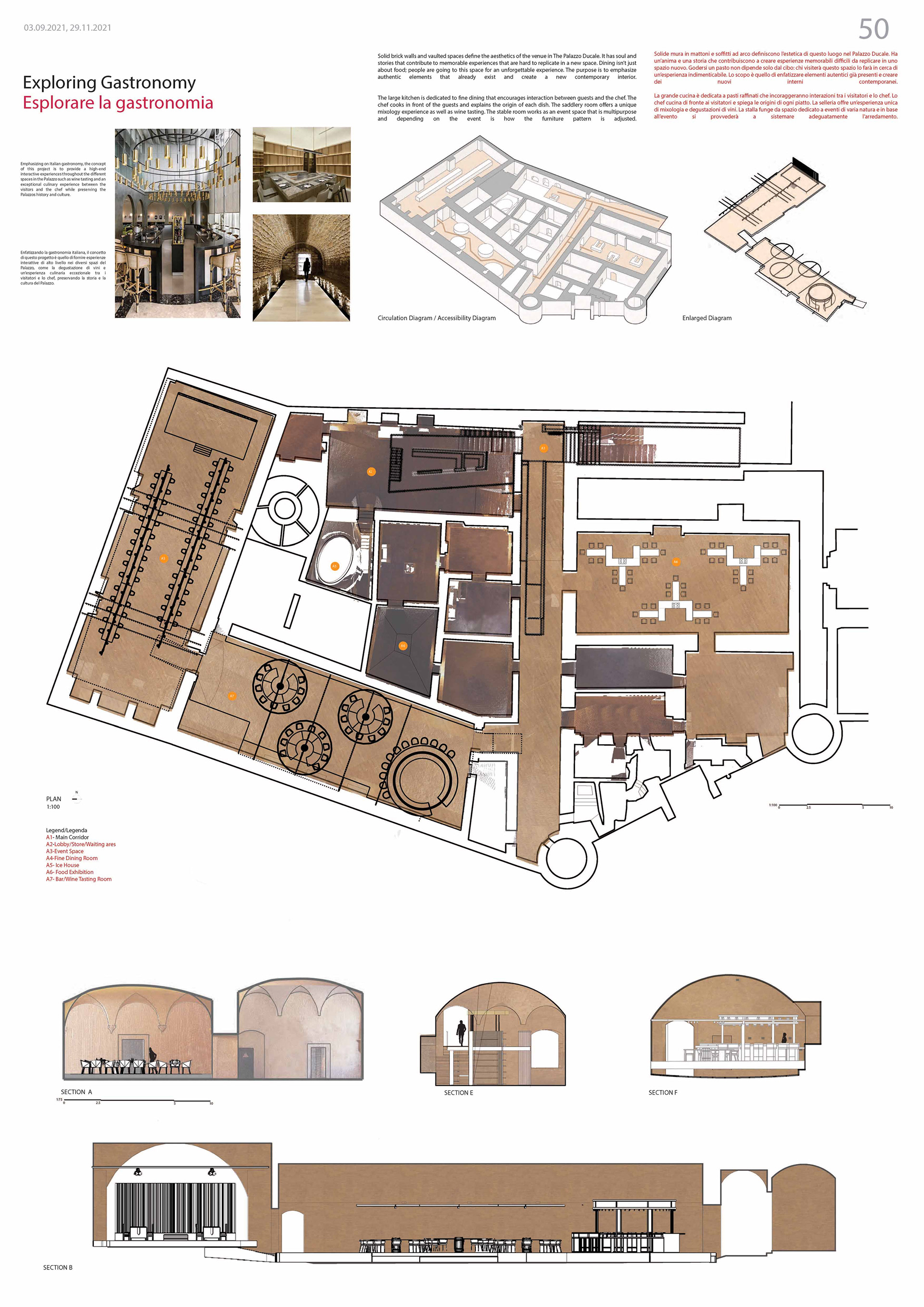
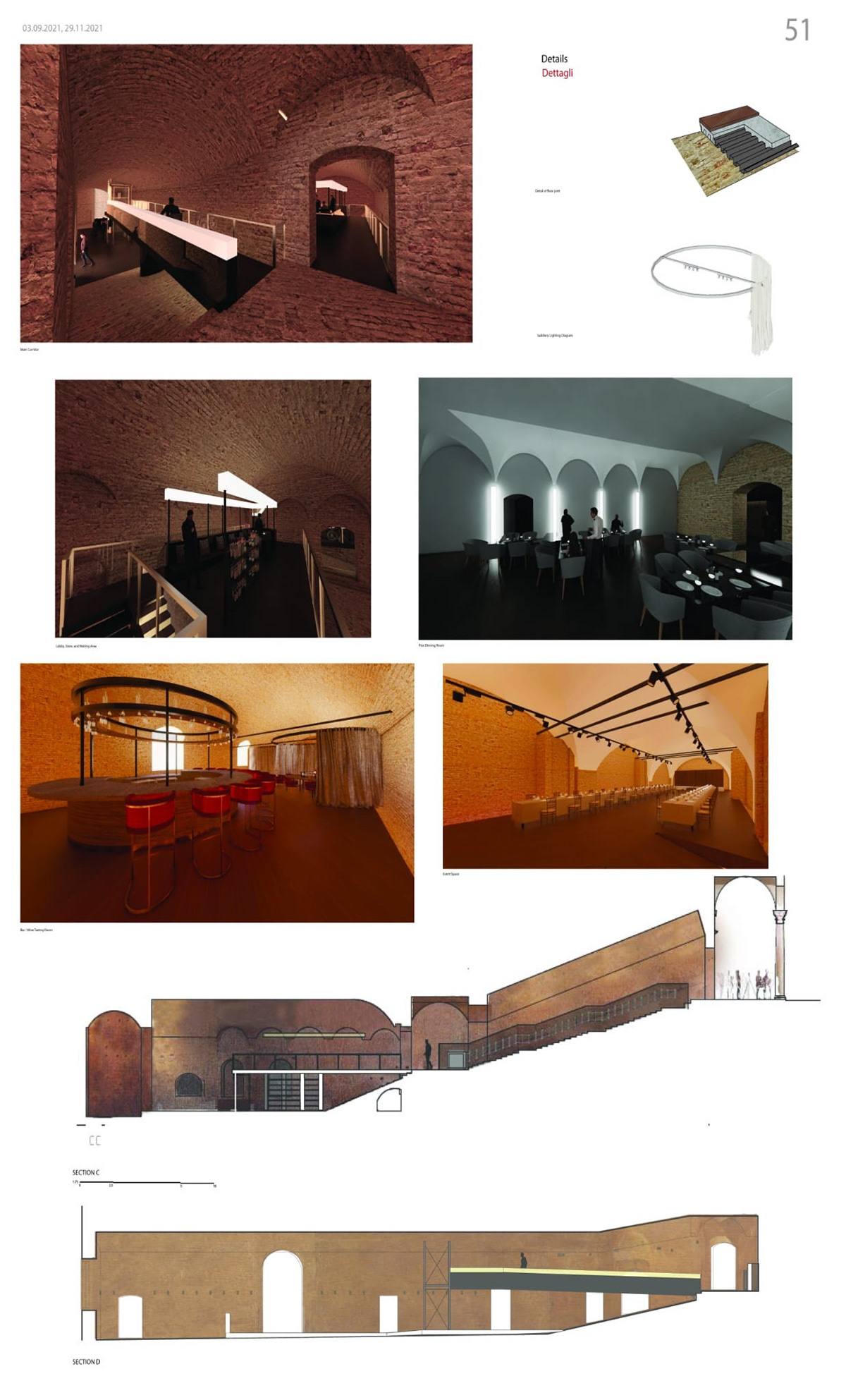
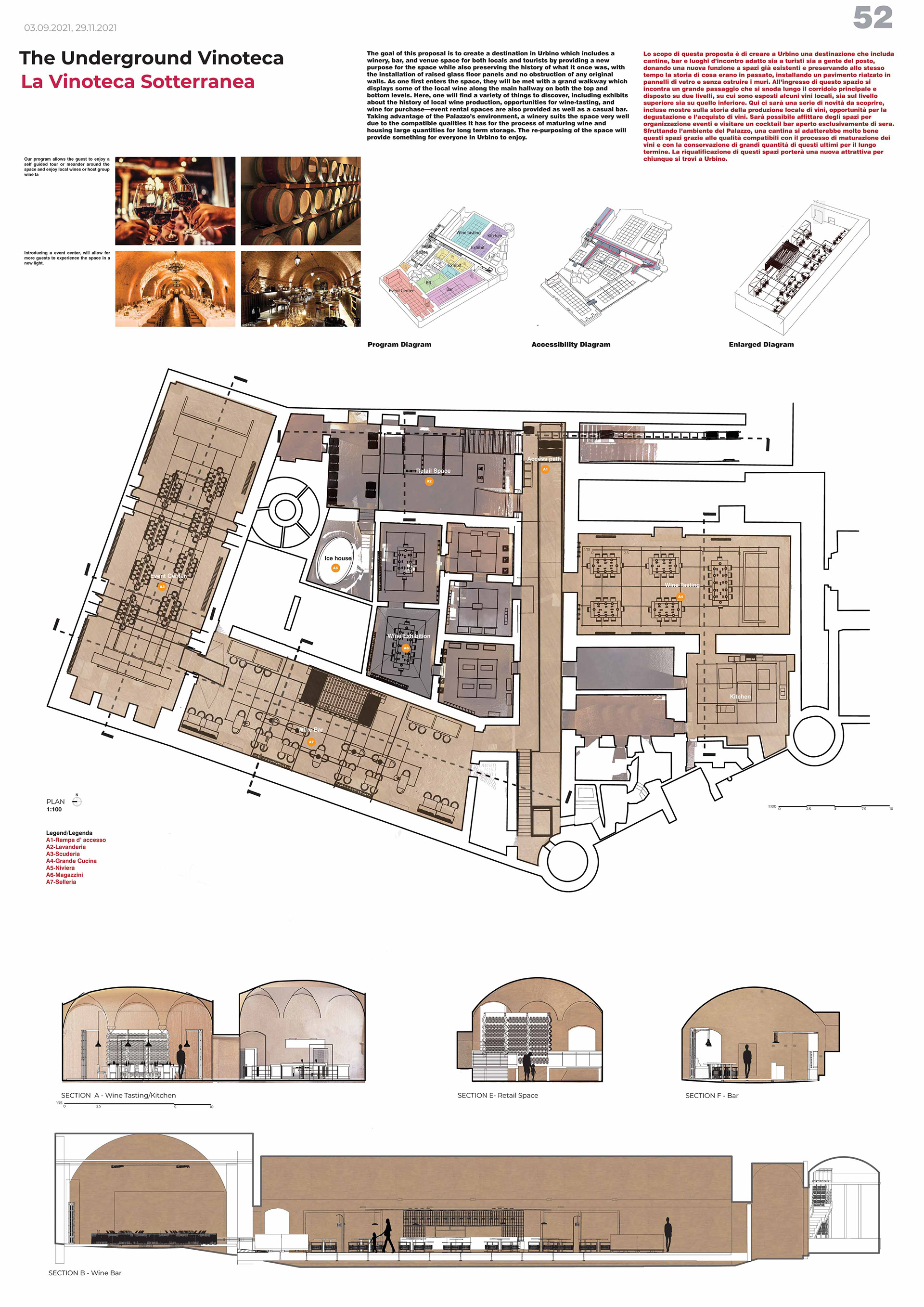
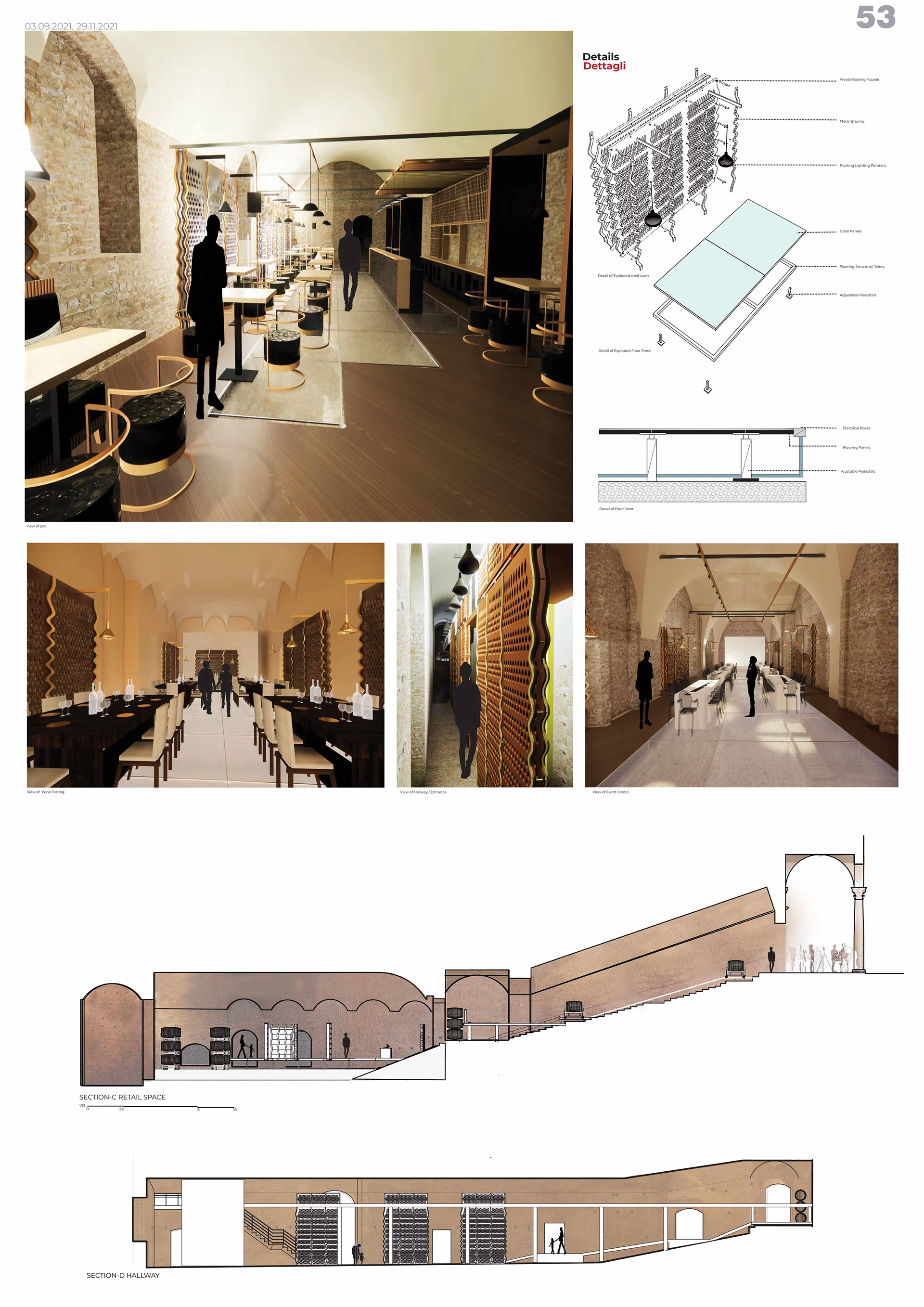
“The hidden museum”: the American students of the UTSA reinterpret the underground spaces of the Doge's Palace
by Emanuela Braico | 26 Nov 2021 | Highlights , Portal , We unite | News
On Monday 29 November, at 10.30 am, in the Winter Garden Room of the Ducal Palace of Urbino, Urbinate will be staged forever. The hidden museum : fourth investigation perspective of the Urbinate forever international project . Architectures of light and spirit , promoted by Uniurb as part of the Prorectorate for the Development of National and International Strategic Partnerships, and dedicated to Carlo Bo on the 110th anniversary of his birth and on the twentieth of his death.
The occasion will allow to attend the presentation of the results of an exceptional research and teaching experience conducted, in a semester of study in Urbino, by students of the Faculty of Architecture of the University of Texas at San Antonio . An experience which, proceeding through multiple developments and inspired by Bo's pages dedicated to the Doge's Palace, finds its raison d'être in the participation that unites not only Uniurb and the Texan University , but also the City of Urbino and the National Gallery. of the Marche .
"This project - explained the Rector Giorgio Calcagnini - demonstrates that a clear vision shared with neighboring institutions is certainly an opportunity to be pursued vigorously, like the collaboration with the University of Texas at San Antonio and, more in general, with international academic networks.
With Professor John Murphy, Dean of the partner University, we have established a relationship of great cordiality and mutual trust, which supports and nourishes our professional exchange. We are in complete harmony with the management of the work and this allows us to foresee new training and research projects .
With Professor John Murphy, Dean of the partner University, we have established a relationship of great cordiality and mutual trust, which supports and nourishes our professional exchange. We are in complete harmony with the management of the work and this allows us to foresee new training and research projects .
Among other things, in full agreement with the Rectors of the other universities in the Marche region, I made a proposal to reserve a percentage of beds within the university residences to be used for the hospitality of foreign teachers and students , so as to encourage the policies of internationalization and foster partnerships and best practices that make an important contribution to the University and the city ".
Led by professors John Murphy , Curtis Fish and Derryl Olenbush of the University of Texas at San Antonio and by Architects Monica Mazzolani and Antonio Troisi , of Studio MTA Associati - Giancarlo De Carlo Associati , the class of the UTSA Global Study Center Italy in Urbino returned the digital design of a museum space in the basement of the Doge's Palace .
“The School of Architecture and Planning of the University of Texas at San Antonio - commented Professor John Murphy - is grateful for the opportunity offered by the Carlo Bo University and the city of Urbino, during the fall semester of 2021. Develop a project “In the field”, within a historically significant context such as the Doge's Palace, proved to be a unique experience for our students and our teachers.
I would like to offer a special thanks to the Rector of the University of Urbino, Giorgio Calcagnini, for supporting our project and for welcoming us with friendship and enthusiasm. During the last ten years we have constantly collaborated with the aim of giving ever greater impetus to the international cooperation that involves us , and to our personal bond.
The UTSA Global Study Center Italy based in Urbino will continue to invest in this partnership with the aim of enhancing the respective peculiarities, also creating high-level training opportunities for American and Italian students ".
The UTSA Global Study Center Italy based in Urbino will continue to invest in this partnership with the aim of enhancing the respective peculiarities, also creating high-level training opportunities for American and Italian students ".
The laser scanner technology provided by the University of Urbin has allowed the students to acquire, through very accurate surveys, precious information on the architectures of the undergrounds that accompany the Casa del Duca, and has allowed them to develop a geometric database which, together with the results of the he investigation of the materials, returns to the city and its institutions an unprecedented all-round mapping of the spaces, functional to any consolidation and reinforcement interventions .
“In the name of Carlo Bo - said the mayor Maurizio Gambini - another project of great interest takes shape. And we are particularly pleased to see the students of the Faculty of Architecture of San Antonio involved , young people who can look at the urban fabric of our city with the gaze of those who are exposed for the first time to the stratifications created in Urbino in different eras. In harmony with the municipal administrations that followed one another, Carlo Bo had an important role in the development of Urbino in the 1900s. The Urbinate Forever initiative . The hidden museum is a further opportunity to reflect on the way in which Bo was able to "read" the context in which he worked for over 50 years, as he managed to narrate and enhance it ".
In fact, moving within the perimeter of Bo's story of the Palazzo and always in dialogue with the interpretative and expressive suggestions of Giancarlo De Carlo , the project will presumably deliver, beyond the fundamental data, artistic solutions that even deviating from the more congenial formula of the exhibition set-up, they will be able, through adventurous invention, to give these hidden rooms a new life. We will have proof of this in the beginning of the week.
Meanwhile, the added value of this international educational and research adventure that seems to be undoubted is confirmed by the reflection of the architect Stefano Brachetti, Officer for the promotion and communication of MIBAC - Galleria Nazionale delle Marche, which ends by renewing the mantra of Uniurb.
Meanwhile, the added value of this international educational and research adventure that seems to be undoubted is confirmed by the reflection of the architect Stefano Brachetti, Officer for the promotion and communication of MIBAC - Galleria Nazionale delle Marche, which ends by renewing the mantra of Uniurb.
“Young scholar architects, born and raised in lands of which - those who wanted and built this building - did not know existed, came to question the architecture of the Ducal Palace in Urbino: yet the Palace speaks to them too. We, of the National Gallery of the Marches, are pleased to host these initiatives that enrich the life and mission of the institute and to share this experience with them, and other partners.
Too often, the mass media convey to us the image of museums reduced to mere figures - number of visitors, income, etc. - or spaces for amusing bored tourists. Instead, museums are organisms created to respond to a variety of cultural needs including - as the definition of the ICOM museum, also reported in our Code of Cultural Heritage states - education and study. It is therefore always a source of pride for a museum institution to host scholars and, together with them, to be a bridge between different cultures to grow in knowledge ".
Too often, the mass media convey to us the image of museums reduced to mere figures - number of visitors, income, etc. - or spaces for amusing bored tourists. Instead, museums are organisms created to respond to a variety of cultural needs including - as the definition of the ICOM museum, also reported in our Code of Cultural Heritage states - education and study. It is therefore always a source of pride for a museum institution to host scholars and, together with them, to be a bridge between different cultures to grow in knowledge ".
Tiziana Mattioli legge “Confessione di Nicodemo”, di Carlo Bo
da Emanuela Braico | 25 Nov 2021 | In evidenza, Portale, Uniamo | News
Nel febbraio del 1992, Valerio Volpini chiedeva a Carlo Bo, sulla scorta dei passi del Vangelo di Giovanni, una interpretazione in forma di racconto della fede inquieta di Nicodemo. Il Magnifico rispose confezionando, per lettera, un soliloquio compostamente tormentoso in cui la luce profonda dell’interrogazione sul segreto conflitto tra essere e dover essere si scioglieva in toni delicatissimi di preghiera. Era l’invocazione dolente di Nicodemo, era l’invocazione dolente di Carlo Bo.
La prosa, dattiloscritta e sconosciuta, è stata pubblicata in plaquette col titolo Confessione di Nicodemo, su premura del Rettore Giorgio Calcagnini, il 21 luglio 2021 nel ventesimo anniversario della morte di Bo. Il ritrovamento del documento e la cura della stampa, ad opera dell’editore Raffaelli, si devono a Tiziana Mattioli, docente di Letteratura italiana dell’Ateneo urbinate, che ha ideato e coordinato il progetto internazionale Urbinate per sempre. Architetture della luce e dello spirito, promosso nell’ambito del Prorettorato allo Sviluppo di Partenariati Strategici Nazionali e Internazionali di Uniurb.
Alla studiosa e all’amore pieno che ha per il mestiere della letteratura si deve anche l’interpretazione di queste pagine inedite, che nella sua voce trovano la forza di un’intrepida trasparenza e verità.
Professoressa Mattioli, nella sua lettura le parole di Bo convergono in un movimento di suoni che dal cuore le porta allo spirito di chi ascolta. Grazie di questa emozione che davvero travolge.
È una pagina di bellezza struggente, intima e sapienziale, questa Confessione di Nicodemo: un inedito di Carlo Bo che il Rettore Giorgio Calcagnini ha voluto pubblicassimo il 21 luglio 2021, proprio per la ricorrenza della scomparsa, in una sobria ed elegante plaquette. Oggi la proponiamo in forma di lettura ad alta voce, entro la serie di mirabili parole che il Grande Rettore ha dedicato alla città e ai suoi artisti.
Certo, in questa narrazione che svolgiamo da quasi un anno, in una vera e propria cordata d’amicizia – anche in un percorso che sentiamo identitario – siamo ora a sostare su riflessioni diverse, quasi su un testamento spirituale, anche se sempre la scrittura di Bo ha valenza etica e autobiografica, per una ricerca che va sempre al cuore dell’uomo, e di ogni autore. Tuttavia ci è sembrato importante includere questo brano proprio nel tempo dell’Avvento, perché tempo di rivelazione e di speranza anche per la coscienza laica.
Vorrei ricordare qui che la volontà che abbiamo condiviso, sin dall’inizio, col Rettore Giorgio Calcagnini e con la prorettrice Antonella Negri, poi con una lunghissima lista di amici e una larga presenza di Istituzioni nazionali e oltre nazionali, non voleva appellarsi solamente ad una occasione celebrativa, ma determinare un tempo lungo di meditazione, di impegno, di studio, di responsabilità di fronte ad una eredità culturale incalcolabile che in Urbino respiriamo ogni giorno, e che ogni giorno, anche al di là della nostra consapevolezza, ci nutre e ci accompagna. Insomma, non è stata una corsa verso il fare, ma proprio verso il pensare.
Il tempo corre verso la conclusione del progetto. Quale bilancio possiamo tentare?
Ci avviciniamo a un tempo di bilanci, proprio al compiersi del progetto, il 25 gennaio prossimo, genetliaco di Carlo Bo, e ancora tante cose ci attendono. Esperienze bellissime, come quella che presenteremo tra pochi giorni, il 29 novembre, alla sala del Giardino d’Inverno, e che avrà per protagonisti gli studenti e i docenti dell’Università di San Antonio (Texas), guidati dal decano John Murphy, che hanno ricostruito in rilievo digitale i sotterranei di Palazzo ducale, e qui allestito una serie di mostre d’arte virtuali che certamente ci affascineranno. Ma anche in questo caso, ciò che può sembrare estemporaneo ed evanescente, lascerà invece la sua importante eredità all’intera città, con la restituzione di un rilievo perfetto e tecnicamente fruibile della realtà ipogea del Palazzo, che brilla, oltre che nell’aria magica di Urbino, anche nel segreto delle sue stanze vicine al cuore della terra.
Ma sono in arrivo anche bellissime pagine di scrittura, da molti luoghi del mondo, che metteremo a disposizione intanto come libri digitali, poi, crediamo, a stampa. E un’ultima lettura, assai importante, che per ora teniamo segreta ma sarà significativa sia per il testo che per l’interpretazione. E l’intera collezione dei brani, con modalità che stiamo approntando e in parte impaginando perché siano di fresca fruibilità.
Volgendoci indietro, dalla mostra che ha inaugurato l’anno, poi trasferita a Sestri Levante, della quale ci resta un prestigioso catalogo oltre l’indimenticabile ricordo del sostegno della famiglia Bo, e del sindaco Valentina Ghio, come dell’assessore Elisa Bixio; dalla pubblicazione della plaquette Confessione di Nicodemo alle attuali undici letture (ché la prima è quasi un numero zero), al lavoro dell’Università di San Antonio, e a ramificate collaborazioni con la mostra attuale a Palazzo Passionei, condivisa con Ursula Vogt, Elena Baldoni, Salvatore Ritrovato: Carlo Bo. La letteratura, le città, la vita (1911-1951) e con la trasmissione “Le Meraviglie” a questo dedicata da Massimo Raffaeli; dagli scritti di Simone Dubrovic, di Marco Faini, di Paola Ugolini, e anche miei, in collaborazione con la cattedra ISIA del Professor Paolo Semprucci, beh, bisogna dire che veramente tanto lavoro è stato fatto. Quotidiano lavoro, con la vicinanza decisiva di sapienti e affettuosi amici. Senza di loro, e senza il sostegno e l’impegno generosissimo di due figure cardinali, come Donatello Trisolino ed Emanuela Braico, le idee che già si erano presentate alla mia mente due anni fa sarebbero volate via, e giunte vicino alle regioni del nulla.
Grazie infinite a lei… abbiamo percorso insieme sentieri di inaudita bellezza. È stato un viaggio sorprendente, sempre sostenuto da ragioni di fiducia e di straordinaria intesa. E adesso che il passo del commiato si avvicina, quali nuovi desideri e sollecitazioni sorveglia?
Il mio desiderio, oltre a quello di continuare a meditare e studiare e anche possibilmente divulgare la parola di Carlo Bo, e dare il mio contributo alla Fondazione per quanto so e posso fare, sarebbe quello di elencare qui, come minima forma di ringraziamento, la lunga lista degli amici, tra i quali non posso non nominare Roberto Danese e Marcella Peruzzi, Monica Mazzolani e Antonio Troisi, il Direttore di Palazzo Ducale, Luigi Gallo, e l’architetto Stefano Brachetti, che ci hanno accolti e ospitati con liberalità. Solo nominandoli tutti, anche tutti i lettori, e i “consiglieri segreti” come Silvia Cuppini e Lucia Pretelli, si potrebbe comprendere appieno la vera, vasta valenza di questo progetto, e di questo anno di lavoro: nell’essere comunità, e insomma impresa culturale collettiva. Essere Ateneo, infine, e quindi tempio di una certa idea della realtà.

